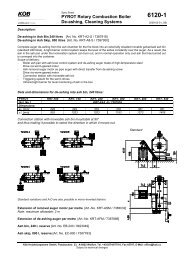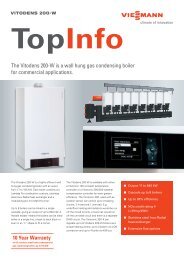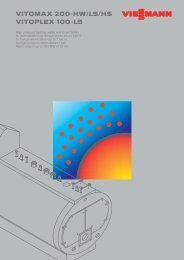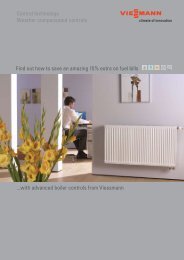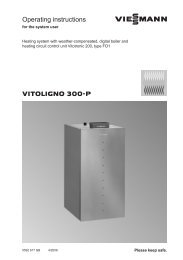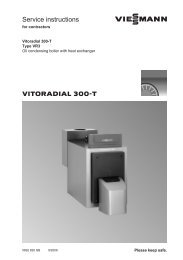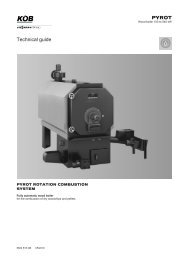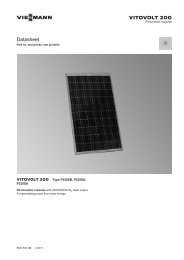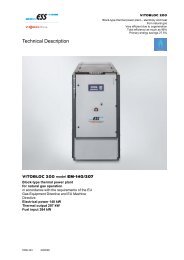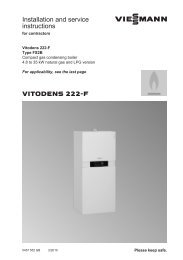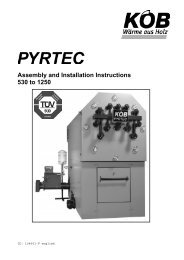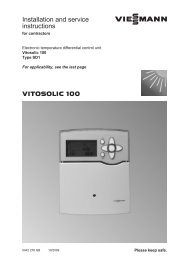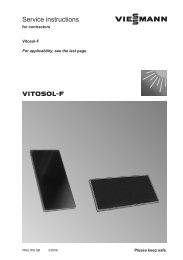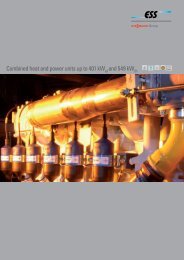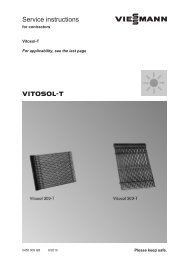Vitodens 242-F Installation instructions15.8 MB - Viessmann
Vitodens 242-F Installation instructions15.8 MB - Viessmann
Vitodens 242-F Installation instructions15.8 MB - Viessmann
You also want an ePaper? Increase the reach of your titles
YUMPU automatically turns print PDFs into web optimized ePapers that Google loves.
<strong>Installation</strong> and serviceinstructionsfor contractorsVIESMANN<strong>Vitodens</strong> <strong>242</strong>-FType FB2ACompact Energy Tower with a gas condensing boiler4.8 to 26 kW natural gas and LPG versionG.C. no: 47-819-18 (19 kW)G.C. no: 47-819-19 (26kW)For applicability, see the last pageVITODENS <strong>242</strong>-F5418 193 GB 6/2009 Please keep safe.
Safety instructionsSafety instructionsPlease follow these safety instructions closely to prevent accidents and materiallosses.Safety instructions explainedDangerThis symbol warns against therisk of injury.!Please noteThis symbol warns against therisk of material losses and environmentalpollution.NoteDetails identified by the word "Note" containadditional information.Target groupThese instructions are exclusivelydesigned for qualified personnel.■ Work on gas equipment must only becarried out by a qualified gas fitter.■ Work on electrical equipment mustonly be carried out by a qualified electrician.■ The system must be commissioned bythe system installer or a qualified personauthorised by the installer.RegulationsObserve the following when working onthis system■ all legal instructions regarding the preventionof accidents,■ all legal instructions regarding environmentalprotection,■ the Code of Practice of relevant tradeassociations,■ all current safety regulations asdefined by DIN, EN, DVGW, TRGI,TRF, VDE and all locally applicablestandards,■ Gas Safety (<strong>Installation</strong> & Use) Regulations– the appropriate Building Regulationeither the Building regulations, theBuilding Regulation (Scotland),Building Regulations (Northern Ireland),– the Water Fittings Regulation orWater Bylaws in Scotland,– the current I.E.E. Wiring Regulations.If you smell gasDangerEscaping gas can lead to explosionswhich may result in seriousinjury.■ Never smoke. Prevent nakedflames and sparks. Neverswitch lights or electrical appliancesON or OFF.■ Close the gas shut-off valve.■ Open windows and doors.■ Remove all people from thedanger zone.■ Notify your gas or electricitysupplier from outside the building.■ Shut off the electricity supply tothe building from a safe place(outside the building).5418 193 GB2
Safety instructionsSafety instructions (cont.)If you smell flue gasDangerFlue gas can lead to life-threateningpoisoning.■ Shut down the heating system.■ Ventilate the boiler room.■ Close all doors leading to theliving space.Working on the system■ When using gas as fuel, also close themain gas shut-off valve and safeguardagainst unauthorised reopening.■ Isolate the system from the power supplyand check that it is no longer 'live',e.g. by removing a separate fuse or bymeans of a main isolator.■ Safeguard the system against unauthorisedreconnection.Ancillary components, spare andwearing partsPlease note! Spare and wearing parts whichhave not been tested togetherwith the heating system can compromiseits function. Installingnon-authorised components andnon-approved modifications/conversioncan compromise safetyand may invalidate our warranty.For replacements, use only originalspare parts from <strong>Viessmann</strong>or those which are approved by<strong>Viessmann</strong>.!Please noteElectronic modules can be damagedby electro-static discharges.Touch earthed objects, such asheating or water pipes, to dischargestatic loads.Repair work!Please noteRepairing components which fulfila safety function can compromisethe safe operation of yourheating system.Replace faulty components onlywith original <strong>Viessmann</strong> spareparts.5418 193 GB3
IndexIndex<strong>Installation</strong> instructionsPreparing for installationProduct information.............................................................................................. 6Preparing for installation....................................................................................... 6<strong>Installation</strong> sequenceInstalling the boiler............................................................................................... 10Opening the control unit casing............................................................................ 15Electrical connections........................................................................................... 16Closing the control unit casing............................................................................. 20Service instructionsCommissioning, inspection, maintenanceSteps - commissioning, inspection and maintenance.......................................... 22Further details regarding the individual steps....................................................... 24Code 1Calling up code 1.................................................................................................. 61General................................................................................................................. 61Boiler.................................................................................................................... 63DHW..................................................................................................................... 66Solar..................................................................................................................... 66Heating circuit 1/heating circuit 2......................................................................... 67Code 2Calling up coding level 2...................................................................................... 72General................................................................................................................. 72Boiler.................................................................................................................... 74DHW..................................................................................................................... 75Solar..................................................................................................................... 76Heating circuit 1/heating circuit 2......................................................................... 78Diagnosis and service scansDiagnosis.............................................................................................................. 81Checking outputs (relay test)................................................................................ 83TroubleshootingFault display......................................................................................................... 85Fault codes........................................................................................................... 86Repairs................................................................................................................. 935418 193 GB4
IndexIndex (cont.)Function descriptionInternal extensions............................................................................................... 108External extensions (accessories)........................................................................ 110Control functions.................................................................................................. 112Remote control DIP switches............................................................................... 118Electronic combustion controller.......................................................................... 119DesignsInternal connection diagram................................................................................. 121External connection diagram................................................................................ 122Connection diagram solar control module............................................................ 124Parts lists............................................................................................................ 125Commissioning/service reports........................................................................ 135Specification....................................................................................................... 136CertificatesDeclaration of conformity...................................................................................... 137Manufacturer's certificate according to the 1st BImSchV [Germany]................... 138Keyword index.................................................................................................... 1395418 193 GB5
Preparing for installationProduct information<strong>Vitodens</strong> <strong>242</strong>-F, FB2ASet up for operation with natural gas H.For conversion to LPG P (without conversion kit), see page 30.The <strong>Vitodens</strong> <strong>242</strong>-F should generally only be delivered to those countries specifiedon the type plate. For deliveries to alternative countries, an approved contractor, onhis own initiative, must arrange individual approval in accordance with the law of theland.Preparing for installationTransportIf possible, leave the boiler on the palletduring handling.If space constraints make it necessary,the boiler can be split for handling.<strong>Installation</strong> instructions provided!Please noteTo prevent equipment damage,never set the boiler down onits front or side panels or applyloads to these areas.<strong>Installation</strong>Required room height: min. 2100 mm and the boiler weight is 161 (19kW) to 165kg(26kW) (dry).Preparing the boiler installationUse a connection set, available as anaccessory, to make the connection onthe gas and water sides. The followingoverview shows sample connection setsfor installation on finished walls to the topor side.Preparing the connections on site:Connection set installationinstructions.!Please noteTo prevent equipment damage,install all pipework free of loadand torque stresses.5418 193 GB6
Preparing for installationPreparing for installation (cont.)4494363703205011356560140110010013671422147715321587164216971752180718751930199620084640<strong>Installation</strong>7195418 193 GBDEABC4403302205550600FGH50224595A Solar return R ¾"B Heating flow R ¾"C DHW R ½"D Gas connection R ½"E DHW circulation R ½" (separateaccessory)F Cold water R ½"G Heating return R ¾"H Solar flow R ¾"K Condensate drain to the back intothe wallL Side condensate drainM Cable entryN DHW safety valve drain7
Preparing for installationPreparing for installation (cont.)NoteThe adjustable feet give all height measurementsa tolerance of +15 mm.1. Prepare the heating water connections.Flush the heating system thoroughly.NoteShould an additional diaphragmexpansion vessel be required on site,connect that vessel into the heatingreturn.2. Prepare the DHW connections. Installthe safety assembly (accessory or onsiteprovision) in accordance withThe Water Fittings Regulations 1999 inthe cold water line (see page 9).Recommendation:Install the safety valve above the DHWcylinder to protect it against contamination,scaling and high temperatures.Connect the drain hose to the condensatecollector. Remove plug from condensatecollector.3. Route condensate hose O to theback (drain in wall K) or to the sideaperture L (see page 6).Route condensate hose with a U-bend and connect to on-site drain lineor siphon. Discharge pipes fromexpansion valves (safety valve)should not be connected directly to adrain and should pass through a visibletundish, with a AUK3 air gap, andbe located adjacent to the device.5418 193 GB8
Preparing for installationPreparing for installation (cont.)4. Prepare the gas connection accordingto TRGI or TRF or all local regulations.Safety assembly to Water Fittings regulations 19995. Prepare the electrical connections.■ Power supply cable: NYM-J 3 x 1.5 mm 2 , fuse max. 16 A,230 V/50 Hz.■ Accessory cables: NYM with therequired number of conductors forthe external connections.■ Allow all cables in area "M" (seepage 7) to protrude 2000 mm fromthe wall.<strong>Installation</strong>A Safety assembly toG Non-return valveWater Fittings regulations 1999 (accessoryto connection sets for unfinished K Cold waterH Drainwalls)L Drinking water filterB Safety valveM Pressure reducer to Water Fittings regulations1999C Visible blow-off line outletD Shut-off valveN Non-return valve/pipe separatorE Flow regulating valve (installation recommended)set (accessory)O Cold water connection at connectionF Pressure gauge connection5418 193 GB9
<strong>Installation</strong> sequenceInstalling the boilerAssembling the boiler8.2.5.7.6.3.1.2x4.9.5418 193 GB10
<strong>Installation</strong> sequenceInstalling the boiler (cont.)Connections on the heating water and the DHW sideShown with connection sets for finished walls (accessories)A Heating flow R ¾"B DHW R ½"C DHW circulation R ½" (separateaccessory)D Cold water R ½"E Heating return R ¾"Fitting the drain outlet and drain line to the T&P valveSeparate installation instructions5418 193 GB<strong>Installation</strong>11
<strong>Installation</strong> sequenceInstalling the boiler (cont.)DHW circulation connectionDHW circulation connection withDHW circulation pump connectionset (accessory)Separate installation instructionsConnections on the solar sideShown with connection sets for finished walls (accessories)A Solar return R ¾" B Solar flow R ¾"NoteThe solar circuit pump is integrated intothe boiler.Install the expansion vessel, available asan accessory, in the solar return onsite.5418 193 GB12
<strong>Installation</strong> sequenceInstalling the boiler (cont.)Separate installation instructionsSet the safety valve on the solar side andthe pressure gauge for the solar circuiton site.NoteRoute the blow-off pipe for the safetyvalve on the solar side into a suitable andadequately sized drip container.Gas connection<strong>Installation</strong>A Gas connection R ½"Notes regarding operation with LPG.We recommend the installation of anexternal safety solenoid valve wheninstalling the boiler in rooms belowground level.2. Carry out a tightness test.5418 193 GB1. Fix gas shut-off valve to gas connectionA.13
<strong>Installation</strong> sequenceInstalling the boiler (cont.)NoteFor the tightness test, use only suitableand approved leak detectingagents (EN 14291) and devices.Leak detecting agents with unsuitablecontents (e.g. nitrides, sulphides)can lead to material damage.Remove residues of the leak detectingagent after testing.3. Vent the gas line.For conversion to a different gas typesee page 30!Please noteExcessive test pressure maydamage the boiler and the gasvalve.Max. test pressure 150 mbar.Where higher pressure isrequired for tightness tests,separate the boiler and thegas valves from the gas supplypipe (undo the fitting).Flue gas connectionConnect the balanced flue. The flue terminalshave to be installed as describedin accordance with the Building RegulationsPart J and BS 5440.Flue gas system installationinstructions.5418 193 GB14
<strong>Installation</strong> sequenceOpening the control unit casing3.2.2x1.<strong>Installation</strong>5.4.7x5418 193 GB15
<strong>Installation</strong> sequenceElectrical connectionsInformation regarding the connection of accessoriesFor the connection, observe the separate installation instructions providedwith the accessory components.Please note! Electronic modules can be damaged by electrostatic discharges.Before beginning work, touch earthed objects, such as heating or water pipes,to discharge static loads.C%AaVG?!M1~BN? L L?N N? L1N?L230V~ 230V~DX47654321100 35 20 96 40X35321A Solar control module KM BUS connection(connected in the deliveredcondition)B Solar control module power supplyPlug 230 V~sA Cylinder primary pump E (fittedand connected)C External safety solenoid valve(LPG)D Cyl. primary pumpfÖ Power supply5418 193 GB16
<strong>Installation</strong> sequenceElectrical connections (cont.)DangerIncorrect core terminationcan cause severe injuriesand damage to the equipment.Take care not to interchangecores "L1" and "N".■ Remove any existing individualcores.■ Install an isolator in the powersupply line that simultaneouslyisolates all non-earthed conductorsfrom the mains with at least3 mm contact separation.Remove the existing cable grommetwhen using larger cross-sections(up to 714 mm). Secure thecable with cable grommet F (seepage 19) integrated into the casingbase.■ Max. fuse rating 16 A.gD External safety solenoid valve(LPG) DDo not remove jumper between "1"and "L" when making this connection.lH Accessories and solar control modulepower supplyWhere the boiler is installed in a wetarea, the connection of accessoriesto the power supply must not be carriedout at the control unit. Thepower supply connection for accessoriescan be made immediately atthe control unit, if the boiler is installedoutside wet areas. This connectionis controlled directly with thesystem ON/OFF switch (max. 3 A)Low voltage plug X3! Outside temperature sensor (onlyfor weather-compensated controlunits)<strong>Installation</strong>:■ North or north-western wall, 2 to2.5 m above ground level; in multistoreybuildings, in the upper halfof the second floor■ Not above windows, doors or ventilationoutlets■ Not immediately below balconiesor gutters■ Never render over■ Cable length max. 35 m with across-section of 1.5 mm 2? Flow temperature sensor for lowloss header (accessories)% Cylinder temperature sensor (fittedand connected)aVG KM BUS subscriber (accessory)■ Vitotrol 200 or 300 remote control(only for weather-compensatedcontrol units)■ Extension kit for one heating circuitwith mixer (only for weathercompensatedcontrol units)■ External extension H1 or H2■ Open Therm extension5418 193 GB<strong>Installation</strong>17
<strong>Installation</strong> sequenceElectrical connections (cont.)Connecting the collector temperature sensorNoteSolar control module A is attached tothe l.h. side of the air box.aVG% & AConnect collector temperature sensor& to terminal box B of the prewiredlead connected to solar control moduleA.On-site extension cable: 2-core, crosssection1.5 mm 2 .B% Cylinder temperature sensor (fittedand connected)5418 193 GB18
<strong>Installation</strong> sequenceElectrical connections (cont.)Routing the connecting cablesPlease note! Connecting cables will be damaged if they touch hot parts.When routing and securing power cables on site, ensure that the maximumpermissible temperatures for these cables are not exceeded.A Low voltage connectionsB 230 V connectionsC Internal extensionD Main PCBE Communication module (accessories)F Cable grommet for power supplycable5418 193 GB<strong>Installation</strong>19
<strong>Installation</strong> sequenceClosing the control unit casing (cont.)Wall mounting base installationinstructions5418 193 GB<strong>Installation</strong>21
Commissioning, inspection, maintenanceSteps - commissioning, inspection and maintenanceFor further information regarding the individual steps, see the page indicatedCommissioning stepsInspection stepsMaintenance stepsPage• • 1. Removing the front panels............................................ 24• 2. Filling the heating system.............................................. 24• 3. Changing the language (if required)............................. 25• 4. Setting the time and date (if required).......................... 26• 5. Venting the boiler........................................................... 26• 6. Venting the heating system........................................... 26• 7. Filling siphon with water................................................ 27• 8. Filling the solar circuit................................................... 28• • • 9. Checking all connections on the heating water sideand DHW side for leaks• 10. Checking power supply connection• 11. Naming the heating circuits........................................... 28• • 12. Checking the gas type.................................................... 29• 13. Gas type conversion (only for operation with LPG).... 30• • • 14. Function sequence and possible faults....................... 30• • • 15. Checking the static and supply pressure..................... 32• 16. Setting the maximum output......................................... 33• • 17. Checking the balanced flue system tightness (annulargap check)....................................................................... 3422• 18. Burner removal............................................................... 35• 19. Checking the burner gasket and the burner gauzeassembly......................................................................... 36• 20. Checking and adjusting the ignition and ionisationelectrodes........................................................................ 37• 21. Cleaning the heat exchanger and fitting the burner.... 37• • 22. Checking the condensate drain and cleaning thesiphon.............................................................................. 395418 193 GB
Commissioning, inspection, maintenanceSteps - commissioning, inspection and… (cont.)Commissioning stepsInspection stepsMaintenance stepsPage• 23. Checking the neutralising system (if installed)• 24. Checking the anode connection................................... 40• 25. Testing the anode earth current with an anode tester 40• 26. Draining the boiler on the DHW side............................ 42• 27. Cleaning the primary cylinder....................................... 43• 28. Checking and replacing the magnesium anode (ifrequired).......................................................................... 44• 29. Returning the primary cylinder into use....................... 45• • 30. Checking the diaphragm expansion vessel andsystem pressure............................................................. 46• • • 31. Checking the function of safety valves• • • 32. Checking electrical connections for tightness• • • 33. Checking gas equipment for tightness at operatingpressure........................................................................... 46• • 34. Checking the combustion quality................................. 47• • • 35. Checking the external LPG safety valve (if installed)• 36. Matching the control unit to the heating system......... 48• 37. Adjusting the heating curves........................................ 54• 38. Connecting the control unit to the LON....................... 56• 39. Scanning and resetting the "Service" display............. 58• • • 40. Fitting the front panels................................................... 59• 41. Instructing the system user........................................... 605418 193 GBService23
Commissioning, inspection, maintenanceFurther details regarding the individual stepsRemoving the front panelsSee page 10, steps 1 to 5.Filling the heating systemPlease note! Unsuitable fill water increases the level of deposits and corrosion and maylead to boiler damage.■ Thoroughly flush the entire heating system prior to filling it with water.■ Only use fill water of potable quality.■ Soften fill water with hardness exceeding 300ppm (3.0 mmol/l), e.g. use asmall softening system for heating water (see Vitoset price list).■ An antifreeze additive suitable for heating systems can be mixed with thefill water.Shown with connection set for finished walls (accessory)1. Check the pre-charge pressure of thediaphragm expansion vessel.2. Close the gas shut-off valve.3. Fill heating system via boiler fill &drain valve A in the heating return(at the connection set on the side orabove the boiler). (Minimum systempressure > 1.0 bar).5418 193 GB24
Commissioning, inspection, maintenanceFurther details regarding the individual steps (cont.)NoteIf the control unit has not beenswitched ON prior to filling the system,then the servomotor of thediverter valve will still be in its centralposition, and the system will be completelyfilled.NoteLever on valve B must be in the"l.h." position.4. If the control unit had already beenswitched ON before filling began:Switch control unit ON and activatefilling program (see next steps).NoteFor function and details of the fill program,see page 113.5. Close boiler fill & drain valve A.Activating the filling function:1. Press OK and simultaneously forapprox. 4 s.2. "Service functions"3. "Filling"4. Ending filling function:Press OK or .Changing the language (if required)NoteAt the commissioning stage, the displayis in German (default setting)Extended menu:1. å2. "Settings"3. "Language"SpracheDeutschCeskyDanskEnglishWählen mitØDECZDKGB4. Set the required language with / .ç5418 193 GBService25
Commissioning, inspection, maintenanceFurther details regarding the individual steps (cont.)Setting the time and date (if required)During commissioning, or after prolongedtime out of use, the time and dateneed to be reset.Extended menu:2. "Settings"3. "Time / Date"4. Set current time and date.1. åVenting the boiler1. Close the shut-off valves on the heatingwater side.2. Remove cover panel A.3. Connect the drain hose on valve Bwith a drain.4. Open air vent valve B and fill valveC in the heating return and ventusing mains pressure (flush) until nomore air noise can be heard.5. Close valve B and fill valve C in theheating return, and open the shut-offvalves on the heating water side.Venting the heating system1. Close the gas shut-off valve andswitch ON the control unit.2. Activate venting program (see nextsteps).5418 193 GB26
Commissioning, inspection, maintenanceFurther details regarding the individual steps (cont.)NoteFor function and sequence of theventing program, see page 113.3. Check the system pressure.Activating the venting function:2. "Service functions"3. "Air vent valve"4. Ending venting function:Press OK or .1. Press OK and simultaneously forapprox. 4 s.Filling siphon with water1. Pivot control unit forward.2. Pull retaining clip A off.3. Pull filler pipe B upwards.4. Pull off lute C downwards.5. Fill siphon with water and reassemble.6. Refit cover panel.7. Secure control unit back in operatingposition.5418 193 GBService27
Commissioning, inspection, maintenanceFurther details regarding the individual steps (cont.)Filling the solar circuitSolar thermal system installation and service instructions2. Fill the solar circuit via fill valve Awith "Tyfocor LS".Minimum system pressure: 1.7 bar.Permiss. operating pressure: 6 bar.Please note! To prevent equipment damage,use only "Tyfocor LS".Never fill with water!3. Close ball valve of fill valve A.4. Open the air vent valve at the solarcollector.A Solar circuit fill valvePlease note! Overheated collector areas andoverheated heat transfer mediumcan cause burns/scalding andequipment damage.When working on the collectorand the solar circuit, protect thecollector area against solar irradiation.5. Start solar circuit pump via a relaytest (see page 83).6. Let the solar circuit pump run until thesolar circuit is fully vented. At a systempressure below 1.7 bar top upwith "Tyfocor LS".7. Close the air vent valve at the solarcollector.8. Check system pressure. Below1.7 bar top up with "Tyfocor LS".1. Thoroughly flush the on-site pipework.Naming the heating circuitsIn the delivered condition, the heatingcircuits are designated "Heating circuit1" and "Heating circuit 2" (if installed).28If the system user prefers, the heatingcircuits can be designated differently tosuit the specific system.5418 193 GB
Commissioning, inspection, maintenanceFurther details regarding the individual steps (cont.)Enter names for heating circuits:Operating instructionsChecking the gas typeThe boiler is equipped with an electronic combustion control unit that adjusts theburner for optimum combustion in accordance with the prevailing gas quality.■ Consequently, for natural gas there is no adjustment required across the entireWobbe range.The boiler can be operated in the Wobbe index range 9.5 to 15.2 kWh/m 3 (34.2 to54.7 MJ/m 3 ).■ Convert the burner for operation with LPG (see "Gas type conversion" onpage 30).1. Determine the gas type and Wobbeindex by asking your local gas supplyutility or LPG supplier.3. Record the gas type in the servicereport on page 135.2. Convert the burner for operation withLPG (see page 30).5418 193 GBService29
Commissioning, inspection, maintenanceFurther details regarding the individual steps (cont.)YesIgnition No Fault F4 Check the ignitionmodule (controlvoltage 230 Vacross plugs"X2.1" and "X2.2")YesGas train opens No Fault F4 Check the gas train(control voltage230 V); check thegas supply pressureYesIonisation currentbuildsSymbol ANo Fault F4 Check the ionisationelectrodeadjustment and thegas pipe for airlocksYesBurner in operationNoStops below theset boiler watertemperature andrestarts immediatelyCheck the flue gassystem for soundness(flue gasrecirculation),check the gas flowpressure5418 193 GBService31
Commissioning, inspection, maintenanceFurther details regarding the individual steps (cont.)YesAutomatic calibrationof the combustioncontrolunitNo Fault Eb Check the connectingcable andthe ionisation electrode,check the flue gassystem (flue gasrecirculation)For further details regarding faults, seepage 85.Checking the static and supply pressureDangerCO build-up as a result of an incorrect burner setup can have serious healthimplications.Carry out a CO test prior to and after work on gas equipment.Operation with LPGFlush the LPG tank twice during commissioning/replacement. Thoroughly vent thetank and gas supply lines after flushing.1. Close the gas shut-off valve.2. Undo the screw inside test connector"PE" A at the gas train but do notremove it, and connect the pressuregauge.3. Open the gas shut-off valve.4. Measure the static pressure andrecord it in the service report onpage 135.Set value: max. 37 mbar5418 193 GB32
Commissioning, inspection, maintenanceFurther details regarding the individual steps (cont.)5. Start the boiler.NoteDuring commissioning, the boiler canenter a fault state because of airlocksin the gas line. After approx. 5 s pressthe reset button R (see operatinginstructions) to reset the burner.6. Check the supply (flow) pressure.Set value:■ Natural gas: 20 mbar■ LPG: 37 mbarNoteUse suitable test equipment with aresolution of at least 0.1 mbar tomeasure the supply pressure.7. Record the actual value in the servicereport on page 135.Take the action shown in the followingtable.8. Shut down the boiler, close the gasshut-off valve, remove the pressuregauge and close test nipple A withthe screw.9. Open the gas shut-off valve and startup the boiler.DangerGas escaping from the testnipple leads to a risk of explosion.Check test connector A fortightness.Supply (flow) pressurefor naturalgasSupply (flow)pressure for LPGMeasuresbelow 15 mbar below 25 mbar Do not start the boiler. Notify your mainsgas or LPG supplier.15 to 25 mbar 25 - 45 mbar Start the boiler.above 25 mbar above 45 mbar Install a separate gas pressure governorupstream of the system and regulate thepre-charge pressure to 20 mbar for naturalgas or 37 mbar for LPG. Notify yourmains gas or LPG supplier.Setting the maximum outputServiceYou can limit the maximum output for heating operation. The limit is set via themodulation range. The max. adjustable heating output is limited upwards by the boilercoding card.1. Press OK and å simultaneouslyfor approx. 4 s.3. "Max. output"5418 193 GB2. "Service functions"33
Commissioning, inspection, maintenanceFurther details regarding the individual steps (cont.)4. "Change?" Select "Yes".A value flashes on the display (e.g."85"). In the delivered condition, thisvalue represents 100 % of rated output.5. Set the required value.Checking the balanced flue system tightness (annular gapcheck)A Combustion air port (ventilation air)We recommend that your heating engineercarries out a simple leak/tightnesstest during the commissioning of yoursystem. For this, it would be sufficient tocheck the CO 2 or O 2 concentration in thecombustion air at the annular gap of thebalanced flue pipe.The flue pipe is deemed to be gas-tightif the CO 2 concentration in the combustionair is no higher than 0.2 % or theO 2 concentration is at least 20.6 %.If actual CO 2 values are higher or O 2 valuesare lower, then pressure test the fluepipe with a static pressure of 200 Pa.For balanced flue systems testedtogether with the wall mounted gas firedboiler, the requirement for a tightnesstest during commissioning by the fluegas inspector is not applicable.5418 193 GB34
Burner removalCommissioning, inspection, maintenanceFurther details regarding the individual steps (cont.)4x5418 193 GBService1. Switch ON/OFF switch at the controlunit and the main power supplyOFF.2. Close the gas shut-off valve and safeguardagainst reopening.35
Commissioning, inspection, maintenanceFurther details regarding the individual steps (cont.)3. Pull electrical cables from fan motorA, gas valve B, ionisation electrodeC, ignition unit D and earthtab E.4. Undo gas supply pipe fitting F.5. Release four nuts G and remove theburner.Please note! Prevent damage to the wiregauze.Never rest the burner on thegauze assembly.Checking the burner gasket and the burner gauze assemblyCheck burner gasket A and burner gauze assembly E for damage and replace, ifrequired.BFEDAC3x5418 193 GB36
Commissioning, inspection, maintenanceFurther details regarding the individual steps (cont.)1. Remove electrodes B.2. Undo three retaining clips C at thermalinsulation ring D and removethermal insulation ring D.3. Undo four Torx screws and removeburner gauze assembly E with itsgasket F.4. Insert and secure a new burnergauze assembly E with a new gasketF.Torque: 3.5 Nm.5. Refit thermal insulation ring D.6. Refit electrodes B.Torque: 2.5 Nm.Checking and adjusting the ignition and ionisation electrodes6 +2 010 ±1AA4 +0,50BA Ignition electrodesB Ionisation electrode1. Check the electrodes for wear andcontamination.2. Clean the electrodes with a smallbrush (not with a wire brush) or sandpaper.3. Check the electrode gaps. If the gapsare not as specified or the electrodesare damaged, replace and align theelectrodes together with new gaskets.Tighten the electrode fixingscrews with 2.5 Nm.Cleaning the heat exchanger and fitting the burnerService!Please noteScratches on parts that are in contact with flue gas can lead to corrosion.Never use brushes to clean the heat exchanger.5418 193 GB37
Commissioning, inspection, maintenanceFurther details regarding the individual steps (cont.)3. Thoroughly flush the heatexchanger A with water.4. Install the burner. Fit the screw with aserrated washer and the remainingscrews, then tighten diagonally with4 Nm torque.5. Fit the gas supply pipe with a newgasket.6. Check the gas connections for tightness.1. Use a vacuum cleaner to remove residuesfrom the heat exchanger Ainside the combustion chamber.2. If required, spray slightly acidic,chloride-free cleaning agents basedon phosphoric acid onto heatexchanger A and let the solutionsoak in for approx. 20 min.DangerEscaping gas leads to a risk ofexplosion.Check all fittings for gas tightness.7. Connect the electrical cables/leads toeach corresponding component.5418 193 GB38
Commissioning, inspection, maintenanceFurther details regarding the individual steps (cont.)Checking the condensate drain and cleaning the siphon1. Check that the condensate can drainfreely at the siphon.2. Pull retaining clip A off.3. Pull filler pipe B upwards.4. Pull off lute C downwards.5. Pull the condensate hose from luteC.6. Clean the siphon.7. Fill siphon with water and reassemble.5418 193 GBService39
Commissioning, inspection, maintenanceFurther details regarding the individual steps (cont.)Checking the anode connectionCheck that the earth lead is connected tothe magnesium anode.1.2.B AA Magnesium anodeB Earth cableTesting the anode earth current with an anode testerNoteWe recommend that the magnesium anode function is checked annually. This functiontest can be carried out without interrupting operation, by measuring the earthcurrent with an anode tester.5418 193 GB40
Commissioning, inspection, maintenanceFurther details regarding the individual steps (cont.)B CA1. Remove cover A.2. Pull earth lead B from tab C.3. Connect the tester (up to 5 mA) inseries between tab C and earthcable B.■ The anode is OK if the indicatedcurrent is > 0.3 mA.■ Visually inspect the anode, if thecurrent measures < 0.3 mA or ifthere is no current at all (seepage 44).5418 193 GBService41
Commissioning, inspection, maintenanceFurther details regarding the individual steps (cont.)Draining the boiler on the DHW side1. Connect hose to drain valve androute into a suitable container or drainoutlet.NoteEnsure adequate ventilation in theDHW pipework.2. Turn drain valve from lever positionA to lever position B or C asrequired.■ Lever position B: Drain heatingsystem excluding cylinder via thecold water connection.■ Lever position C: Drain heatingsystem and cylinder via the DHWconnection. Cold water connectionremains filled.5418 193 GB42
Cleaning the primary cylinderCommissioning, inspection, maintenanceFurther details regarding the individual steps (cont.)NoteEN 806 specifies a visual inspection and (if required) cleaning every two years afterthe cylinder has been taken into use and thereafter according to requirements.BC DAEService1. Drain the primary cylinder.2. Remove flange lid A.3. Remove T&P valve B.5. Dispose of gasket E.6. Disconnect the primary cylinder fromthe pipework to prevent contaminationfrom entering the pipe system.5418 193 GB4. Undo eight screws C and removeflange lid D.43
Commissioning, inspection, maintenanceFurther details regarding the individual steps (cont.)7. Remove loose deposits with a highpressure cleaner.9. Thoroughly flush the primary cylinderafter cleaning.!Please noteWhen cleaning the inside,only use plastic cleaning utensils.8. Use a chemical cleaning agent toremove hard deposits that cannot beremoved by a high pressurecleaner.Please note! Never use hydrochloric acidbased cleaning agents.Checking and replacing the magnesium anode (if required)Check the magnesium anode. If it is discovered that the anode has degraded to 10to 15 mm Ø, we recommend replacing the magnesium anode.5418 193 GB44
Returning the primary cylinder into useCommissioning, inspection, maintenanceFurther details regarding the individual steps (cont.)EDCFBA1. Reconnect the primary cylinder to thepipework.2. Insert new gasket A underneathflange lid B.3. Fit flange lid B and tighten eightscrews D with up to 25 Nm.4. Push earth cable C onto the tab.5. Fit T&P valve E.6. Fit cover F.7. Fill the primary cylinder with drinkingwater.5418 193 GBService45
Commissioning, inspection, maintenanceFurther details regarding the individual steps (cont.)Checking the diaphragm expansion vessel and system pressureNoteCarry out this test on a cold system.1. Drain the system, until the pressuregauge indicates "0".2. If the diaphragm expansion vesselinlet pressure is lower than the staticsystem pressure: Top up with nitrogenvia connection A, until the inletpressure is 0.1 to 0.2 bar.3. Top up your heating system withwater and vent until the filling pressureof a cooled system is 0.1 to 0.2bar higher than the inlet pressure ofthe diaphragm expansion vessel.Permiss. operating pressure: 3 barChecking gas equipment for tightness at operating pressureDangerEscaping gas leads to a risk ofexplosion.Check gas equipment for tightness.NoteFor the tightness test, use only suitableand approved leak detecting agents (EN14291) and devices. Leak detectingagents with unsuitable contents (e.g.nitrides, sulphides) can lead to materialdamage.Remove residues of the leak detectingagent after testing.5418 193 GB46
Checking the combustion qualityCommissioning, inspection, maintenanceFurther details regarding the individual steps (cont.)The electronic combustion control unit automatically ensures an optimum combustionquality. Only the combustion values need to be checked during commissioning andmaintenance. For this, check the CO 2 or O 2 content. For a function description of theelectronic combustion control unit, see page 119.Please note! To prevent operating faults and equipment damage,never operate with dirty combustion air.CO 2 or O 2 content■ The CO 2 content must be within the following ranges (upper and lower output):– 7.7 to 9.2% for natural gas H– 9.3 to 10.9% for LPG P■ For all gas types, the O 2 content must be between 4.4% and 6.9%.If the actual CO 2 or O 2 values lie outside their respective ranges, proceed with thefollowing steps:■ Check the balanced flue system for tightness, see page 34.■ Check the ionisation electrode and connecting cable, see page 37.NoteDuring commissioning, the combustion control unit carries out an automatic calibration.Only test the emissions approx. 30 s after the burner has started.2. Open the gas shut-off valve, start theboiler and create a heat demand.3. Select the lower output (seepage 48).4. Check the CO 2 content. Should theactual value deviate from the aboveranges by more than 1%, implementsteps from page 47.Service5418 193 GB1. Connect a flue gas analyser at fluegas port A on the boiler flue connection.5. Enter actual values into the servicereport.6. Select the upper output (seepage 48).47
Commissioning, inspection, maintenanceFurther details regarding the individual steps (cont.)7. Check the CO 2 content. Should theactual value deviate from the aboveranges by more than 1%, implementsteps from page 47.8. After testing, press OK.9. Enter actual values into the servicereport.2. "Actuator test"3. Select the lower output:Select "Base load" "ON" and confirmwith OK.4. Select the upper output:Select "Full load" "ON" and confirmwith OK.To set the upper/lower output:1. Press OK and simultaneously forapprox. 4 s.Matching the control unit to the heating systemSubject to the equipment level, the control unit must be matched to the system. Varioussystem components are recognised automatically by the control unit and therelevant codes are adjusted automatically.■ For the selection of an appropriate design, see the following diagrams.■ For coding steps, see page 61.5418 193 GB48
Commissioning, inspection, maintenanceFurther details regarding the individual steps (cont.)System version 1One heating circuit without mixer A1wPwQ3121 <strong>Vitodens</strong> <strong>242</strong>-F2 Outside temperature sensor3 Heating circuit without mixer A1wP Solar collectorswQ Collector temperature sensorRequired codeOperation with LPG 82:15418 193 GBService49
Commissioning, inspection, maintenanceFurther details regarding the individual steps (cont.)System version 2One heating circuit with mixer M2 and a low loss header3wPwQ4512679 M81 <strong>Vitodens</strong> <strong>242</strong>-F2 Outside temperature sensor3 Heating circuit with mixer M24 Temperature limiter for limiting themaximum temperature of underfloorheating systems5 Flow temperature sensor M26 Heating circuit pump M27 Extension kit for one heating circuitwith mixer M28 Low loss header9 Flow temperature sensor, low lossheaderwP Solar collectorswQ Collector temperature sensorRequired codingOperation with LPG 82:1System with only one heating circuit with mixer and DHW heating 00:45418 193 GB50
Commissioning, inspection, maintenanceFurther details regarding the individual steps (cont.)System version 3One heating circuit without mixer A1 and one heating circuit with mixer M23 4wPwQ56721 8 M1 <strong>Vitodens</strong> <strong>242</strong>-F2 Outside temperature sensor3 Heating circuit without mixer A14 Heating circuit with mixer M25 Temperature limiter for limiting themaximum temperature of underfloorheating systemsNoteThe volume flow of the heating circuitwithout mixer must be at least 30%greater than the volume flow of the heatingcircuit with mixer.6 Flow temperature sensor M27 Heating circuit pump M28 Extension kit for one heating circuitwith mixer M2wP Solar collectorswQ Collector temperature sensorService5418 193 GBRequired codingOperation with LPG 82:151
Commissioning, inspection, maintenanceFurther details regarding the individual steps (cont.)System version 4One heating circuit without mixer A1, one heating circuit with mixer M2 andsystem separation3 45wPwQ6qP7128 M91 <strong>Vitodens</strong> <strong>242</strong>-F2 Outside temperature sensor3 Heating circuit without mixer A14 Heating circuit with mixer M25 Temperature limiter for limiting themaximum temperature of underfloorheating systems6 Flow temperature sensor M27 Heating circuit pump M28 Extension kit for one heating circuitwith mixer M29 Heat exchanger for system separationqP Construction kit with mixer (accessory)wP Solar collectorswQ Collector temperature sensorRequired codingOperation with LPG 82:15418 193 GB52
Commissioning, inspection, maintenanceFurther details regarding the individual steps (cont.)System version 5One heating circuit with mixer M1 (with Vitotronic 200-H), one heating circuitwith mixer M2 (with extension kit) and low loss header (with/without DHW heating)wPwQ4 3 7521 6 M qQ MqE89qPqW1 <strong>Vitodens</strong> <strong>242</strong>-F2 Outside temperature sensor3 Heating circuit with mixer M14 Flow temperature sensor M15 Heating circuit pump M16 Vitotronic 200-H7 Heating circuit with mixer M28 Temperature limiter for limiting themaximum temperature of underfloorheating systems9 Flow temperature sensor M2qP Heating circuit pump M2qQ Extension kit for one heating circuitwith mixer M2qW Low loss headerqE Flow temperature sensor, low lossheaderwP Solar collectorswQ Collector temperature sensorService5418 193 GBRequired codingOperation with LPG 82:1System with only one heating circuit with mixer and DHW heating 00:453
Commissioning, inspection, maintenanceFurther details regarding the individual steps (cont.)Adjusting the heating curvesThe heating curves illustrate the relationshipbetween the outside temperatureand the boiler water or flow temperature.To put it simply: The lower the outsidetemperature, the higher the boiler wateror flow temperature.The room temperature, again, dependson the boiler water or the flow temperature.Settings in the delivered condition:■ Slope = 1.4■ Level = 0Boiler water orflow temperature in °C9080706050403.0 3.23.42.6 2.82.42.2Slope2.01.81.61.41.21.00.80.60.4BA300.235 30 25 20 15 10 5Set room temperature in °C1050 -5 -10 -15 -20 -25Outside temperature in °C-30A Heating curve slope for underfloorheating systemsB Heating curve slope for low temperatureheating systems (according tothe Energy Savings Order [Germany])5418 193 GB54
Commissioning, inspection, maintenanceFurther details regarding the individual steps (cont.)Changing the slope and levelAdjusting the set room temperature903.5Standard room temperatureBoiler water orflow temperature in °CAB+20 -20Outside temperature in °C1.40.2A Changing the slopeB Changing the level (vertical paralleloffset of the heating curve)Extended menu:1. å2. "Heating"3. Select a heating circuit: "HC1" or"HC2".4. "Heating curve"5. "Slope" or "Level"6. Select heating curve according to therequirements of the system.CD90A26 + 20B-20EExample 1: Adjustment of the standardroom temperature from 20 to 26°CA Boiler water temperature or flowtemperature in °CB Outside temperature in °CC Set room temperature in °CD Heating circuit pump "OFF"E Heating circuit pump "ON"Adjustment of the standard roomtemperature:Operating instructions5418 193 GBService55
Commissioning, inspection, maintenanceFurther details regarding the individual steps (cont.)Reduced room temperature90AC Set room temperature in °CD Heating circuit pump "OFF"E Heating circuit pump "ON"Adjustment of the reduced room temperature:CB-20Operating instructions+20 14 5DEExample 2: Adjustment of the reducedroom temperature from 5 °C to 14 °CA Boiler water temperature or flowtemperature in °CB Outside temperature in °CConnecting the control unit to the LONThe LON communication module(accessories) must be plugged in.<strong>Installation</strong> instructionsLON communication moduleNoteIn the same LON system, the same numbercannot be allocated twice.Only one Vitotronic may be programmedas fault manager.NoteThe data transfer via LON can take severalminutes.Single boiler system withVitotronic 200-H and Vitocom 300(example)Set the LON subscriber numbers andfurther functions via code 2 (see the followingtable).5418 193 GB56
Commissioning, inspection, maintenanceFurther details regarding the individual steps (cont.)Boiler control unit Vitotronic 200-H Vitotronic 200-H VitocomLON LON LONSubscriber no. 1Code "77:1"Control unit is faultmanagerCode "79:1"Control unit transmitsthe timeCode "7b:1"Control unit transmitsoutside temperatureSet code "97:2"LON subscriber faultmonitoringCode "9C:20"Subscriber no. 10Code "77:10"Control unit is notfault managerCode "79:0"The control unitreceives the timeSet code "81:3"The control unitreceives the outsidetemperatureSet code "97:1"LON subscriber faultmonitoringCode "9C:20"Subscriber no. 11Set code "77:11"Control unit is notfault managerCode "79:0"The control unitreceives the timeSet code "81:3"The control unitreceives the outsidetemperatureSet code "97:1"LON subscriber faultmonitoringCode "9C:20"Subscriber no.99Device is faultmanagerDevicereceives thetime——Carrying out a LON subscriber checkCommunication with the system devices connected to the fault manager is testedwith a subscriber check.Preconditions:■ The control unit must be programmedas fault manager (code "79:1")■ The LON subscriber number must beprogrammed in all control units (seepage 57)■ The LON subscriber list in the faultmanager must be up to date (seepage 57)Carrying out a subscriber check:2. "Service functions"3. "Subscriber check"Service5418 193 GB1. Press OK and å simultaneouslyfor approx. 4 s.57
Commissioning, inspection, maintenanceFurther details regarding the individual steps (cont.)4. Select subscriber (e.g. subscriber10).The subscriber check for the selectedsubscriber is introduced.■ Successfully tested subscribersare designated with "OK".■ Unsuccessfully tested subscribersare designated with "Not OK".NoteIf the subscriber check is carried outby another control unit, the subscribernumber and "Wink" areshown on the display for approx.1 min.NoteTo carry out a new subscriber check,create a new subscriber list withmenu item "Delete list?"Scanning and resetting the "Service" displayAfter the limit values specified in coding address "21" and "23" have been reached,"Service" and " " appear on the programming unit display.Scanning and resetting servicePress OK to acknowledge a servicemessage.NoteAn acknowledged service message thatwas not reset reappears the followingMonday.2. "Service functions"3. "Service reset"NoteThe selected service parameters forhours run and time interval restartat 0.After a service has been carried out(reset service)1. Press OK and simultaneously forapprox. 4 s.5418 193 GB58
Fitting the front panelsCommissioning, inspection, maintenanceFurther details regarding the individual steps (cont.)4.1.2.2x5.3.5418 193 GBService59
Commissioning, inspection, maintenanceFurther details regarding the individual steps (cont.)Instructing the system userThe system installer must hand the operatinginstructions to the system user andinstruct him/her in the operation of thesystem.5418 193 GB60
Code 1Calling up code 1Note■ The codes are displayed as plain text.■ Codes that have no function due to theheating system equipment level or thesetting of other codes are not displayed.■ Heating systems with one heating circuitwithout mixer and one heating circuitwith mixer:The heating circuit without mixer isdesignated with "Heating circuit 1"and the heating circuit with mixer with"Heating circuit 2".If the heating circuits were given individualdesignations (see page 28), theselected designation and "HC1" or"HC2" appear instead of the above.1. Press OK and simultaneously forapprox. 4 s.2. "Coding level 1"3. Select group of required codingaddress:■ "General"■ "Boiler"■ "DHW"■ "Solar"■ "Heating circuit 1/heating circuit2"4. Select coding address.5. Select value according to the followingtables and confirm with OK.6. If you want to reset all codes to thedelivered condition:Select "Standard setting" in "Codinglevel 1".GeneralCodingCoding in the delivered conditionSystem design00:2 System version 1:One heating circuit withoutmixer A1, with DHWheatingPossible change00:4 System version 2, 5:One heating circuit withmixer M2, with DHW heating00:6 System version 3, 4:One heating circuit withoutmixer A1 and one heatingcircuit with mixer M2, withDHW heating5418 193 GBService61
Code 1General (cont.)Coding in the delivered conditionInternal circulation pump function51:0 Internal circulation pumpis always started whenthere is a heat demandUser no.77:1 LON user number 77:2to77:99Possible change51:1 When there is a heatdemand, the internal circulationpump will only bestarted when the burner isoperational. System withheating water buffer cylinderLON subscriber number,adjustable from 1 to 99:1 - 4 = Boiler5 = Cascade10 - 98 = Vitotronic 200-H99 = VitocomNoteAllocate each numberonly onceDetached house/apartment building7F:1 Detached house 7F:0 Apartment buildingSeparate adjustment ofholiday program and timeprogram for DHW heating,as optionLock out controls8F:0 All control elementsactive8F:1 All control elements lockedoutOnly setting test mode possible8F:2 Standard menu and testmode enabledExtended menu locked out5418 193 GB62
Code 1General (cont.)Coding in the delivered condition Possible changeExt. Heating program changeover to heating circuit91:0 No external heating programchangeover viaexternal extension91:1 The external heating programchangeover affectsthe heating circuit withoutmixer91:2 The external heating programchangeover affectsthe heating circuit withmixer91:3 The external heating programchangeover affectsthe heating circuit withoutmixer and the heating circuitwith mixerSet flow temperature in case of ext. demand9b:0 No minimum flow temperaturein case of externaldemand9b:1to9b:127Set value for minimum flowtemperature in case ofexternal demand, adjustablefrom 1 to 127 °C (limitedby boiler-specific parameters)BoilerCoding5418 193 GBCoding in the delivered conditionBurner service in 100 hours21:0 No maintenance interval(hours run) selectedService interval in months23:0 No time interval forburner servicePossible change21:1to21:10023:1to23:24The number of hours runbefore the burner shouldbe serviced is adjustablefrom 100 to 10 000 hOne adjusting step ≙ 100hInterval adjustable from 1to 24 months63Service
Code 1Boiler (cont.)Coding in the delivered condition Possible changeService status24:0 No "Service" display 24:1 "Service" display (theaddress is automaticallyset and must be manuallyreset after a service hasbeen carried out)Filling/venting2F:0 Venting program/fill program2F:1 Venting program enableddisabled2F:2 Fill programenabledExt. pump blocking32:0 Influence of the signal"External blocking" on circulationpumps: Allpumps in control function32:1to32:15Influence of the signal"External blocking" on circulationpumps: See thefollowing tableNoteGenerally, the burner will be blocked when signal "External blocking" is enabled.Valueaddress32: ...Internal circulationpumpHeating circuitpumpHeating circuitwithout mixerHeating circuitpumpHeating circuitwith mixerCirculationpump for cylinderheating0 Control funct. Control funct. Control funct. Control funct.1 Control funct. Control funct. Control funct. OFF2 Control funct. Control funct. OFF Control funct.3 Control funct. Control funct. OFF OFF4 Control funct. OFF Control funct. Control funct.5 Control funct. OFF Control funct. OFF6 Control funct. OFF OFF Control funct.7 Control funct. OFF OFF OFF8 OFF Control funct. Control funct. Control funct.9 OFF Control funct. Control funct. OFF10 OFF Control funct. OFF Control funct.11 OFF Control funct. OFF OFF12 OFF OFF Control funct. Control funct.13 OFF OFF Control funct. OFF14 OFF OFF OFF Control funct.15 OFF OFF OFF OFF5418 193 GB64
Code 1Boiler (cont.)Coding in the delivered condition Possible changeExt. pump demand34:0 Influence of the signal"External demand" on thecirculation pumps: Allpumps in control function34:1to34:23Influence of the signal"External demand" on thecirculation pumps: See thefollowing tableValueaddress34: ...Internal circulationpumpHeating circuitpumpHeating circuitwithout mixerHeating circuitpumpHeating circuitwith mixerCirculationpump for cylinderheating0 Control funct. Control funct. Control funct. Control funct.1 Control funct. Control funct. Control funct. OFF2 Control funct. Control funct. OFF Control funct.3 Control funct. Control funct. OFF OFF4 Control funct. OFF Control funct. Control funct.5 Control funct. OFF Control funct. OFF6 Control funct. OFF OFF Control funct.7 Control funct. OFF OFF OFF8 OFF Control funct. Control funct. Control funct.9 OFF Control funct. Control funct. OFF10 OFF Control funct. OFF Control funct.11 OFF Control funct. OFF OFF12 OFF OFF Control funct. Control funct.13 OFF OFF Control funct. OFF14 OFF OFF OFF Control funct.15 OFF OFF OFF OFF16 ON Control funct. Control funct. Control funct.17 ON Control funct. Control funct. OFF18 ON Control funct. OFF Control funct.19 ON Control funct. OFF OFF20 ON OFF Control funct. Control funct.21 ON OFF Control funct. OFF22 ON OFF OFF Control funct.23 ON OFF OFF OFF5418 193 GBService65
Code 1DHWCodingCoding in the delivered condition Possible changeSet DHW temperature with reheating suppression67:40 Subject to the current output67:0 Function switched offof the solar thermalsystem, DHW heating isstarted by the boilerbetween 40 °C actual cylindertemperature and setcylinder temperature.67:1to67:95Start point adjustable from1 to 95 °CEnable DHW circulation pump73:0 DHW circulation pump"ON" according to timeprogram73:1to73:6During the time program1x/h "ON" for 5 minup to 6x/h "ON" for 5 min73:7 Constantly "On"SolarCodingCoding in the delivered condition Possible changeMaximum cylinder temperature08:60 The solar circuit pump willbe switched off when theactual cylinder temperaturereaches 60 °C (maximumcylinder temperature).08:10to08:90Reducing stagnation time0A:5 To protect the system 0A:0components and heat totransfer medium, the 0A:40speed of the solar circuitpump is reduced whenthe differential betweenthe actual cylinder temperatureand set cylindertemperature is less than5 K.66The maximum cylindertemperature can be adjustedfrom 10 to 90 °CThe differential betweenthe set cylinder temperatureand the start point forreducing the stagnationtime can be adjusted from0 to 40 K.5418 193 GB
Code 1Solar (cont.)Coding in the delivered conditionFlow rate0F:70 The flow rate in the collectorcircuit at the maximumpump speed is setto 7 l/min.Possible change0F:1to0F:255Flow rate in the collectorcircuit adjustable from 0.1to 25.5 l/minHeating circuit 1/heating circuit 2CodingCoding in the delivered condition Possible changeSummer eco function outside temperatureA5:5 With heating circuit pumplogic function (economyA5:0 Without heating circuitpump logic functioncircuit): Heating circuitpump "Off" when the outsidetemperature (AT) is1 K higher than the setroom temperature (RT set )A5:1toA5:15With heating circuit pumplogic function: Heating circuitpump "OFF" (see thefollowing table)AT > RT set + 1 KParameter address With heating circuit pump logic function: Heating circuitpump "OFF"A5:...1 AT > RT set + 5 K2 AT > RT set + 4 K3 AT > RT set + 3 K4 AT > RT set + 2 K5 AT > RT set + 1 K6 AT > RT set7AT > RT set - 1 Kto15 AT > RT set - 9 K5418 193 GBService67
Code 1Heating circuit 1/heating circuit 2 (cont.)Coding in the delivered condition Possible changeSummer eco function absoluteA6:36 Extended economy modedisabledA6:5toA6:35Extended economy controlenabled, i.e. the burner andheating circuit pump will beswitched off and the mixerclosed at a variable value,adjustable between 5 and35 °C plus 1 °C. Base valueis the adjusted outside temperature.This value isbased on the actual outsidetemperature and a timeconstant that takes thecooling down of an averagebuilding into consideration.Mixer economy functionA7:0 Without mixer economyfunction (only for heatingcircuits with mixer)Pump idle time change red. modeA9:7 With pump idle time:Heating circuit pump"OFF" in case of set valuemodification by changingthe operating mode orchanging the set roomtemperatureA7:1 With mixer economy function(extended heating circuitpump logic):Heating circuit pump also"OFF":■ If the mixer has beenclosed for longer than20 min.Heating pump "ON":■ If the mixer changes tocontrol function■ If there is a risk of frostA9:0 Without pump idle timeA9:1 With pump idle time;toadjustable from 1 to 15A9:155418 193 GB68
Code 1Heating circuit 1/heating circuit 2 (cont.)Coding in the delivered condition Possible changeWeather-compensated/ room temperature hook-upb0:0 With remote control:Heating mode/reducedmode: (change code onlyfor heating circuit withb0:1 Heating mode: weathercompensatedReduc. mode: with roomtemperature hook-upmixer M2)b0:2 Heating mode: with roomtemperature hook-upReduc. mode: weathercompensatedb0:3 Heating mode/reducedmode: with room temperaturehook-upSummer eco function room temperatureb5:0 With remote control: Noroom temperaturedependentheating circuitpump logic function(change the code only forheating circuit with mixerM2)b5:1tob5:8Heating circuit pump logicfunction, see the followingtable:Parameter With heating circuit pump logic function:address b5:... Heating circuit pump "OFF" Heating circuit pump "ON"1 RT actual > RT set + 5 K RT actual < RT set + 4 K2 RT actual > RT set + 4 K RT actual < RT set + 3 K3 RT actual > RT set + 3 K RT actual < RT set + 2 K4 RT actual > RT set + 2 K RT actual < RT set + 1 K5 RT actual > RT set + 1 K RT actual < RT set6 RT actual > RT set RT actual < RT set - 1 K7 RT actual > RT set - 1 K RT actual < RT set - 2 K8 RT actual > RT set - 2 K RT actual < RT set - 3 KServiceCoding in the delivered conditionFlow temperature minimum limitC5:20 Electronic minimum flowtemperature limit 20 °CPossible changeC5:1toC5:127Minimum limit adjustablefrom 1 to 127 °C (limited byboiler-specific parameters)5418 193 GB69
Code 1Heating circuit 1/heating circuit 2 (cont.)Coding in the delivered condition Possible changeFlow temperature maximum limitC6:74 Electronic maximum flowtemperature limit set to74 °CC6:10toC6:127Maximum limit adjustablefrom 10 to 127 °C (limitedby boiler-specific parameters)Heating program changeoverd5:0 External heating programchangeover changes to"Constant operation withreduced room temperature"d5:1 The external heating programchangeover changesto "Constant operation withstandard room temperature"Max. pump speed in standard modeE6:65 Maximum speed of thevariable speed heatingcircuit pump: 65 % of themaximum speedMin. pump speedE7:30 Minimum speed of thevariable speed heatingcircuit pump: 30 %E6:0toE6:100E7:0toE7:100Screed functionF1:0 Screed function disabled F1:1toF1:6Maximum speed adjustablefrom 0 to 100%Minimum speed adjustablefrom 0 to 100% of the maximumspeedScreed drying functionadjustable in accordancewith 6 optional temperature/timeprofiles (seepage 114)F2:0 No time limit for partyF1:15 Constant flow temperature20 °CParty mode time limitF2:8 Time limit for party modeor external heating programchangeover via key:8 h *1 F2:1tomode *1Time limit adjustable from 1to 12h *1F2:12*1Party mode ends automatically in the "Heating and DHW" program, when thesystem changes over to operation with standard room temperature.705418 193 GB
Code 1Heating circuit 1/heating circuit 2 (cont.)Coding in the delivered condition Possible changeStart temperature raisingF8:-5 Temperature limit for terminatingthe reducedF8:+10tomode -5 ºC, see exampleon page 116.Observe the setting ofcoding address "A3".F8:-60F8:-61+10 to -60 °CFunction disabledEnd temperature raisingF9:-14 Temperature limit for raisingF9:+10the reduced set room totemp. -14 ºC, see exampleF9:-60on page116.Increase set flow temperatureFA:20 Raising the set boilerwater temperature or theset flow temperaturewhen changing fromoperation with reducedroom temperature tooperation with standardroom temperature, by20 %. See example onpage 117.FA:0toFA:50Duration set flow temperature increaseFb:30 Duration for raising the Fb:0set boiler water temperaturetoor the set flow tem-Fb:150perature (see codingaddress "FA") 60 min.See example onpage 117.Temperature limit adjustablefromTemperature limit for raisingthe set room temperatureto the value selectedfor standard mode adjustablefrom+10 to -60 °CTemperature rise adjustablefrom 0 to 50 %Duration adjustable from 0to 300 min;1 step ≙ 2 min5418 193 GBService71
Code 2Calling up coding level 2Note■ In coding level 2, all codes are accessible,including the codes from codinglevel 1.The following lists only those codesnot accessible in coding level 1.■ Codes that have no function due to theheating system equipment level or thesetting of other codes are not displayed.■ Heating systems with one heating circuitwithout mixer and one heating circuitwith mixer:The heating circuit without mixer isdesignated with "Heating circuit 1"and the heating circuit with mixer with"Heating circuit 2".If the heating circuits were given individualdesignations (see page 28), theselected designation and "HC1" or"HC2" appears instead of the above.1. Press OK and simultaneously forapprox. 4 s.3. "Coding level 2"4. Select group of required codingaddress:■ "General"■ "Boiler"■ "DHW"■ "Solar"■ "Heating circuit 1/heating circuit2"5. Select coding address.6. Select value according to the followingtables and confirm with "OK".7. If you want to reset all codes to thedelivered condition:Select "Standard setting" in "Codinglevel 2".NoteThe codes from coding level 1 arealso reset.2. Press OK and simultaneously forapprox. 4 s.GeneralCodingCoding in the delivered condition11:≠9 No access to the codingaddresses for the parametersof the combustioncontroller52:0 Without flow temperaturesensor for low lossheader54:3 Never adjustPossible change11:9 Access open to the codingaddresses for the parametersof the combustion controller52:1 With flow temperature sensorfor low loss header(automatic recognition)5418 193 GB72
Code 2General (cont.)5418 193 GBCoding in the delivered condition6E:50 Never adjust76:0 Without LON communicationmodule79:1 With LON communicationmodule: Control unit isfault manager7b:1 With LON communicationmodule: Control unittransmits the time80:6 A fault message is displayed,providing a faultis active for at least 5 s81:1 Automatic summer/wintertime changeover82:0 Operation with naturalgas86:0 Never adjust87:0 Never adjust88:0 Temperature displayed in°C (Celsius)8A:175 Do not adjust90:128 Time constant for calculatingthe adjusted outsidetemperature 21.3 hPossible change76:1 With LON communicationmodule (automatic recognition)79:0 Control unit is not faultmanager7b:0 Do not transmit time80:0 Immediate fault message80:2 The minimum fault durationtobefore a fault message is80:199 issued is adjustable from10 s to 995 s; 1 step ≙ 5 s81:0 Manual summer/wintertime changeover81:2 Use of the radio clockreceiver (automatic recognition)81:3 With LON communicationmodule: The control unitreceives the time82:1 Operation with LPG (onlyadjustable if codingaddress 11:9 has beenset)88:1 Temperature displayed in°F (Fahrenheit)90:1to90:199Fast (low values) or slow(high values) matching ofthe flow temperature, subjectto the set value whenthe outside temperaturechanges;1 step ≙ 10 minService73
Code 2General (cont.)Coding in the delivered condition94:0 Without Open Thermextension95:0 Without Vitocom 100communication interface97:0 With LON communicationmodule: The outside temperatureof the sensorconnected to the controlunit is utilised internally98:1 <strong>Viessmann</strong> system number(in conjunction withmonitoring several systemsvia Vitocom 300)9C:20 Monitoring LON subscribers.If a subscriber fails torespond, the valuesspecified inside the controlunit will be used after20 min. Only then will afault message be issued.9F:8 Differential temperature8 K; only in conjunctionwith mixer circuitPossible change94:1 With Open Therm extension(automatic recognition)95:1 With Vitocom 100 communicationinterface (automaticrecognition)97:1 The control unit receivesthe outside temperature97:2 The control unit sends theoutside temperature to theVitotronic 200-H98:1 System number adjustabletofrom 1 to 598:59C:0 No monitoring9C:5to9C:609F:0to9F:40The time is adjustable from5 to 60 minDifferential temperatureadjustable from 0 to 40 KBoilerCodingCoding in the delivered condition Possible change06:... Maximum limit of theboiler water temperature,specified in °C by theboiler coding card06:20to06:127Maximum limit of the boilerwater temperature withinthe ranges specified by theboiler12:0 Never adjust5418 193 GB74
Code 2Boiler (cont.)Coding in the delivered condition28:0 No burner interval ignition2E:0 Without external extension30:0 Never adjust31:... Set speed of the internalcirculation pump whenoperated as boiler circuitpump %, specified by theboiler coding card38:0 Status burner control unit:Operational (no fault)Possible change28:1 Time interval adjustabletofrom 1 to 24 h. The burner28:24 is force-started once every30 s (only when operatingwith LPG).2E:1 With external extension(automatic recognition)31:0to31:100Set speed adjustable from0 to 100 %38:≠0 Status burner control unit:FaultDHWCodingCoding in the delivered conditionDHW56:0 Set DHW temperatureadjustable from 10 to60 °CPossible change56:1 Set DHW temperatureadjustable from 10 toabove 60 °CNoteMaximum value subject toboiler coding card.Observe the max. permissibleDHW temperature.Service58:0 Without auxiliary functionfor DHW heating58:10to58:60Input of a second set DHWtemperature, adjustablefrom 10 to 60 °C (observecoding addresses "56" and"63")5418 193 GB75
Code 2DHW (cont.)Coding in the delivered condition Possible change65:... Information regarding thetype of diverter valve; donot adjust.■ 65:0 No diverter valve■ 65:1 <strong>Viessmann</strong>diverter valve■ 65:2 Wilo diverter valve■ 65:3 Grundfos divertervalve6C:100 Set speed; internal primarypump for DHWheating100 %. Never adjust.71:0 DHW circulation pump"ON" according to time71:1 "OFF" during DHW heatingto the first set valueprogram71:2 "ON" during DHW heatingto the first set value72:0 DHW circulation pump"ON" according to time72:1 "OFF" during DHW heatingto the second set valueprogram72:2 "ON" during DHW heatingto the second set valueSolarCodingCoding in the delivered conditionSolar00:8 The solar circuit pumpstarts when the collectortemperature exceeds theactual cylinder temperatureby 8 K.Possible change00:2to00:30The differential betweenthe actual cylinder temperatureand the start point forthe solar circuit pump canbe adjusted from 2 to30 K.5418 193 GB76
Code 2Solar (cont.)5418 193 GBCoding in the delivered condition Possible change01:4 The solar circuit pump isstopped when the differentialbetween the collectortemperature and theactual cylinder temperature01:1to01:29is less than 4 K.29 K.02:2 Solar circuit pump withwave pack control03:10 The temperature differentialbetween the collectortemperature and actualcylinder temperature isregulated to 10 K.04:5 Controller amplification ofthe speed control 5%/K.05:10 Minimum speed of thesolar circuit pump 10% ofthe maximum speed06:80 Maximum speed of thesolar circuit pump 80% ofthe maximum possiblespeed07:0 Interval function of thesolar circuit pumpswitched off09:130 The solar circuit pump willbe switched off when thecollector temperaturereaches 130 °C (maximumcollector temperature).The differential betweenthe actual cylinder temperatureand the stop point forthe solar circuit pump canbe adjusted from 1 to02:0 Solar circuit pump withoutvariable speed (e.g. temporarilyfor service)02:1 Do not adjust03:5to03:2004:1to04:1005:1to05:10006:1to06:100The differential betweenthe collector temperatureand actual cylinder temperaturecan be adjusted from5 to 20 K.Controller amplificationadjustable from 1 to10%/KMinimum speed of thesolar circuit pump is adjustablefrom 1 to 100%Maximum speed of thesolar circuit pump is adjustablefrom 1 to 100%07:1 Interval function of thesolar circuit pump switchedon.To capture the collectortemperature more accurately,the solar circuitpump is started for shortcycles.09:20to09:200The maximum collectortemperature can be adjustedfrom 20 to 200 °C77Service
Code 2Solar (cont.)Coding in the delivered condition0b:0 Collector frost protectionfunction switched off0C:1 Delta T monitoringswitched on.No flow rate captured inthe collector circuit, orflow rate too low.0d:1 Night DHW circulationmonitoring switched on.Unintentional flow rate iscaptured in the collectorcircuit (e.g. at night).0E:1 Function check solaryield with <strong>Viessmann</strong>heat transfer mediumPossible change0b:1 Collector frost protectionfunction switched on (notrequired with <strong>Viessmann</strong>heat transfer medium).0C:0 Delta T monitoringswitched off.0d:0 Night DHW circulationmonitoring switched off.0E:2 Function check solar yieldwith heat transfer mediumwater (do not adjust)0E:0 Function check solar yieldswitched offHeating circuit 1/heating circuit 2CodingCoding in the delivered condition Possible changeA0:0 Without remote control A0:1 With Vitotrol 200 (automaticrecognition)A0:2 With Vitotrol 300 or controlvia Vitohome 200 (automaticrecognition)A3:2 Outside temperaturebelow 1 °C: Heating circuitpump "ON"Outside temperatureabove 3 °C: Heating circuitpump "OFF"A3:-9toA3:15Heating circuit pump "ON/OFF" (see the followingtable)5418 193 GB78
Code 2Heating circuit 1/heating circuit 2 (cont.)!Please noteIf a value is selected below 1 °C, there is a risk of pipes outside the thermalenvelope of the building freezing up.The standby mode, in particular, should be taken into consideration, e.g. duringholidays.ParametersHeating circuit pumpAddress A3:... "ON" "OFF"-9 -10 °C -8 °C-8 -9 °C -7 °C-7 -8 °C -6 °C-6 -7 °C -5 °C-5 -6 °C -4 °C-4 -5 °C -3 °C-3 -4 °C -2 °C-2 -3 °C -1 °C-1 -2 °C 0 °C0 -1 °C 1 °C1 0 °C 2 °C2to1 °Cto3 °Cto15 14 °C 16 °CCoding in the delivered condition Possible changeA4:0 With frost protection A4:1 No frost protection; this settingis only possible if code"A3: -9" has been selected.NoteObserve the informationregarding coding address"A3"ServiceA8:1 Heating circuit with mixercreates a demand for theinternal circulation pumpA8:0 Heating circuit with mixercreates no demand for theinternal circulation pump5418 193 GB79
Code 2Heating circuit 1/heating circuit 2 (cont.)Coding in the delivered condition Possible changeb2:8 With remote control and b2:0 Without room influencefor the heating circuit,operation with room temperatureb2:1toRoom influence factoradjustable from 1 to 64hook-up must beprogrammed: Room influencefactor 8 (changecode only for heating circuitwith mixer)b2:64d3:14 Heating curve slope =1.4d3:2tod3:35Heating curve slope adjustablefrom 0.2 to 3.5 (seepage 54)d4:0 Heating curve level = 0 d4:–13tod4:40Heating curve level adjustablefrom –13 to 40 (seepage 54)E1:1 With remote control: Setvalue for standard roomtemperature adjustable atthe remote control from10 to 30 °CE2:50 With remote control: Nodisplay correction of theactual room temperatureE5:0 Without external, variablespeed heating circuitpumpE8:1 Minimum speed in operationwith reduced roomtemperature subject tothe setting of codingaddress "E9"E9:45 Speed of the variablespeed heating circuitpump: 45% of the maximumspeed in operationwith reduced room temperature80E1:0 Set value for standardroom temperature, adjustablefrom 3 to 23 °CE1:2 Set value for standardroom temperature, adjustablefrom 17 to 37 °CE2:0toE2:49E2:51toE2:99Display correction –5 KtoDisplay correction –0.1 KDisplay correction +0.1 KtoDisplay correction +4.9 KE5:1 With external variablespeed heating circuit pump(automatic recognition)E8:0 Speed subject to the settingin coding address"E7"E9:0toE9:100Speed adjustable from 0 to100% of the maximumspeed during operationwith reduced room temperature5418 193 GB
Diagnosis and service scansDiagnosisOperating data can be scanned in the following areas:■ General■ Heating circuit 1■ Heating circuit 2 (if heating circuit with mixer installed)■ DHW■ Solar■ Brief scan (for further information, see page 81)■ Reset dataNoteIf a sensor that has been scanned is not connected, "- - -" appears on the display.Calling up operating data1. Press OK and simultaneously forapprox. 4 s.3. Select required group, e.g. "General".2. "Diagnosis"Resetting operating dataSaved operating data (e.g. hours run) can be reset to 0.The value "Adjusted outside temp" is reset to the actual value.1. Press OK and simultaneously forapprox. 4 s.3. "Reset data"2. "Diagnosis"Brief scanIn the brief scan, you can scan temperatures, software versions and connected components,for example.Service1. Press OK and simultaneously forapprox. 4 s.2. "Diagnosis"4. Press OK.The display shows 8 lines with 6 fieldseach.5418 193 GB3. "Brief scan".81
Diagnosis and service scansDiagnosis (cont.)Diagnose Kurzabfrage1:2:3:4:1 F 0 A00000000000Wählen mit1 20000000ØFor an explanation of the relevant values in the individual lines, see the followingtable:Line (briefFieldscan)1 2 3 4 5 61: Software versionControl unitEquipment version Burner control unit version2: System designs 01to 06Numberof K<strong>MB</strong>USusersMaximum demand temperature3: 0 SoftwareversionProgrammingunit4: Software versionBurner control unit5: 0: noexternaldemand1: externaldemand ing0: noexternalblocking1: externalblock-6: Number of LON subscribersSoftwareversionMixerextension0: nomixerextensionType0 SoftwareversionLONmoduleAppliance typeBurner control unit0 External 0 to 10 V hook-upDisplay in °C0: no external hook-upCheckdigitMax. outputDetails in %SoftwareversionExternalextension0: no externalextension5418 193 GB82
Diagnosis and service scansDiagnosis (cont.)Line (briefscan)Heating circuit pump to connection exten-7: 0 0 Remotecontrol0 w/o1 Vitotrol2002 Vitotrol300Internal circulationpumpsion8: 0 0 Variablespeedpump0 w/o1 Wilo2 GrundfosField1 2 3 4 5 6BoilerHeating circuit A1(without mixer)Heating circuit withmixer M2Software Remote Softwareversion control versionRemote 0 w/o Remotecontrol 1 Vitotrol control0: no 200 0: noremote 2 Vitotrol remote controlcontrol 300SoftwareversionVariablespeedpump0: no variablespeedpumpVariablespeedpump0 w/o1 Wilo2 GrundfosSoftwareversionVariablespeedpump0: no variablespeedpumpChecking outputs (relay test)1. Press OK and å simultaneouslyfor approx. 4 s.2. "Actuator test"5418 193 GBThe following relay outputs can be controlled subject to system design:DisplayExplanationBase loadBurner modulation base loadFull loadBurner modulation full loadInternal pump ON Int. output 20Htg. system valve Diverter valve set to heating modeValve CentreDiverter valve in central position (filling/draining)Valve Cylinder Diverter valve set to DHW modeHeating circ pump M2 Extension heating circuit with mixerONMix.valve open Extension heating circuit with mixerMix.valve closed Extension heating circuit with mixerService83
Diagnosis and service scansChecking outputs (relay test) (cont.)DisplayOutput internal ONHeating circ pump A1ONCyl. prim. pump ONDHW circ pump ONCentral fault ONSolar circuit pump ONSolar circ pmp min ONSolar circ pmp max ONExplanationOutput sK Internal extensionConnection to external extension H1Connection to external extension H1Connection to external extension H1Connection to external extension H1Solar circuit pump output on solar control module activeSolar circuit pump output on solar control module switchedto minimum speedOutput solar circuit pump on solar control module switchedto maximum speed5418 193 GB84
TroubleshootingFault displayIf there is a fault, the red fault indicatorA flashes. " " flashes on the displayand "Fault" is shown.ARCalling up acknowledged faultsSelect "Fault" in the standard menu.The current faults will be displayed in alist.Calling up fault codes from the faultmemory (fault history)1 2 30 4barThe 10 most recent faults (includingresolved ones) are saved and can bescanned.Faults are sorted by date.The fault code is displayed with OK. Foran explanation of the fault code, see thefollowing pages.For some faults, the type of fault is alsodisplayed in plain text.1. Press OK and simultaneously forapprox. 4 s.2. "Fault history"3. "Display?"Acknowledging a faultFollow the instructions on the display.NoteFault indicator A continues to flash. Thefault message goes into the standarddisplay of the short menu.A fault messaging facility, if connected,will be switched off.If an acknowledged fault is not remedied,the fault message will be re-displayedthe following day.5418 193 GBService85
TroubleshootingFault codesFault codeon the displaySystem characteristics10 Controls as if the outsidetemperaturewere 0 °C18 Controls as if the outsidetemperaturewere 0 °C20 Regulates withoutflow temperaturesensor (low lossheader)28 Regulates withoutflow temperaturesensor (low lossheader)CauseShort circuit, outsidetemperaturesensorLead break, outsidetemperaturesensorShort circuit, systemflow temperaturesensorLead break, systemflow temperaturesensor30 Burner blocked Short circuit, boilerwater temperaturesensor38 Burner blocked Lead break, boilerwater temperaturesensor40 Mixer closes Short circuit, flowtemperature sensor,heating circuit2 (with mixer)48 Mixer closes Lead break, flowtemperature sensor,heating circuit2 (with mixer)50 No DHW heating Short circuit, cylindertemperaturesensor51 No DHW heating Short circuit, outlettemperature sensor58 No DHW heating Lead break, cylindertemperaturesensorMeasuresCheck the outside temperaturesensor (seepage 95)Check the outside temperaturesensor (seepage 95)Check the low loss headersensor (see page 96)Check the low loss headersensor (see page 96)Check the boiler watertemperature sensor (seepage 96)Check the boiler watertemperature sensor (seepage 96)Check flow temperaturesensorCheck flow temperaturesensorCheck sensors (seepage 96)Check sensors (seepage 96)Check sensors (seepage 96)5418 193 GB86
TroubleshootingFault codes (cont.)5418 193 GBFault codeon the displaySystem characteristicsCause59 No DHW heating Lead break, outlettemperature sensor92 No DHW heating Short circuit, collectortemperaturesensor; connectionto the solar controlmodule94 No DHW heating Short circuit, cylindertemperaturesensor; connectionto the solar controlmodule9A No DHW heating Lead break, collectortemperaturesensor; connectionto the solar controlmodule9C No DHW heating Lead break, cylindertemperaturesensor; connectionto the solar controlmodule9E Control mode No flow rate in thecollector circuit orflow rate too low, ortemperature limiterhas responded9F Control mode Solar control modulefaultA7 Control mode as per Faulty programmingdelivered condition unitA8Burner blocked Theventing program isstarted automatically(see page 61)Air lock in the internalcirculationpump or minimumflow rate not achievedMeasuresCheck sensors (seepage 96)Check sensor & on thesolar control module.Check sensor % on thesolar control module.Check sensor & on thesolar control module.Check sensor % on thesolar control module.Check solar circuit pumpand solar circuit. Acknowledgefault message.Check solar control moduleReplace programmingunitVent the system if the faultmessage continues to bedisplayedService87
TroubleshootingFault codes (cont.)Fault codeon the displayA988System characteristicsThe burner operatesat its lower output if aheating circuit withmixer is connected.The burner is blockedif only one heating circuitwithout mixer isconnected.CauseInternal circulationpump blockedb0 Burner blocked Short circuit, fluegas temperaturesensorb1b4b5Control mode as perdelivered conditionControls as if the outsidetemperaturewere 0 °CControl mode as perdelivered conditionCommunicationerror, programmingunitInternal faultInternal faultb7 Burner blocked Boiler coding cardfaultb8 Burner blocked Lead break, fluegas temperaturesensorbA Mixer regulates to 20°C flow temperature.bCbdControl mode withoutremote controlControl mode withoutremote controlCommunicationerror, extension kitfor heating circuit 2(with mixer)Communicationerror, remote controlVitotrol heatingcircuit 1 (withoutmixer)Communicationerror, remote controlVitotrol heatingcircuit 2 (withmixer)MeasuresCheck the circulationpumpChecking the flue gastemperature sensorCheck connections andreplace the programmingunit, if requiredReplacing the control unitReplacing the control unitPlug in boiler coding cardor replace, if faultyChecking the flue gastemperature sensorCheck the extension kitconnections and codingCheck connections,cable, coding address"A0" and remote controlDIP switches (seepage 118)Check connections,cable, coding address"A0" and remote controlDIP switches (seepage 118)5418 193 GB
TroubleshootingFault codes (cont.)5418 193 GBFault codeon the displaySystem characteristicsCausebE Control mode Vitotrol remotecontrol incorrectlyprogrammedbF Control mode Incorrect LONcommunicationmoduleC4 Control mode Communicationerror, Open ThermextensionC5C6C7Control mode, max.pump speedControl mode, max.pump speedControl mode, max.pump speedCommunicationfault, variablespeed internalpumpCommunicationerror, external variablespeed heatingcircuit pump, heatingcircuit 2 (withmixer)Communicationerror, external variablespeed heatingcircuit pump, heatingcircuit 1 (withoutmixer)Cd Control mode Communicationfault, Vitocom 100(KM BUS)CE Control mode Communicationfault, ext. extensionCF Control mode Communicationfault, LON communicationmoduledAControl mode withoutroom influenceShort circuit, roomtemperature sensor,heating circuit1 (without mixer)MeasuresCheck remote control DIPswitch setting (seepage 118)Replace the LON communicationmoduleCheck Open ThermextensionCheck the setting of codingaddress "30"Check setting of codingaddress "E5".Check setting of codingaddress "E5".Check connections,Vitocom 100 and codingaddress "95"Check connections andcoding address "2E"Replace the LON communicationmoduleCheck room temperaturesensor, heating circuit 1Service89
TroubleshootingFault codes (cont.)Fault codeon the displaydbdddE90System characteristicsControl mode withoutroom influenceControl mode withoutroom influenceControl mode withoutroom influenceCauseShort circuit, roomtemperature sensor,heating circuit2 (with mixer)Lead break, roomtemperature sensor,heating circuit1 (without mixer)Lead break, roomtemperature sensor,heating circuit2 (with mixer)E4 Burner blocked Fault, supply voltage24 VE5 Burner blocked Fault – flameamplifierE8 Burner in a fault The ionisation currentstatelies outside theE9EAEbBurner in a faultstateBurner in a faultstateBurner in a faultstatepermissible rangeThe ionisation currentlies outside thepermissible rangeduring calibrationThe ionisation currentlies outside thepermissible rangeduring calibrationHeat draw-offrepeatedly too lowduring calibrationMeasuresCheck room temperaturesensor, heating circuit 2Check room temperaturesensor, heating circuit 1and remote control DIPswitch settings (seepage 118)Check room temperaturesensor, heating circuit 2and remote control DIPswitch settings (seepage 118)Replace the control unit.Replace the control unit.Check the ionisation electrodeand cable.Press reset button R.Check the ionisation electrodeand cable.Check the flue gas systemfor tightness.Press reset button R.Check the ionisation electrodeand cable.Press reset button R.Initiate a heat draw-off.Switch the boiler OFF andON again.Press reset button R.Set coding address 12:1.This special functionleads to heat being transferredto the heating circuitduring calibration.5418 193 GB
TroubleshootingFault codes (cont.)Fault codeon the displayECSystem characteristicsBurner in a faultstateCauseThe ionisation currentlies outside thepermissible rangeduring calibrationInternal faultMeasuresCheck the ionisation electrodeand cable.Press reset button R.Ed Burner in a faultstateReplace the control unit.F0 Burner blocked Internal fault Replace the control unit.F1 Burner in a faultCheck the heating systemstatefill level. Vent the system.F2F3F4F8Burner in a faultstateBurner in a faultstateBurner in a faultstateBurner in a faultstateFlue gas temperaturelimiter hasresponded.The temperaturelimiter has respondedFlame signal isalready present atburner start.No flame signalThe fuel valvecloses too latePress reset button R afterthe flue system hascooled down.Check the heating systemfill level. Check the circulationpump. Vent the system.Check the temperaturelimiter and connectingcables.Press reset button R.Check the ionisation electrodeand connectingcable.Press reset button R.Check the ionisation electrodeand connectingcable, measure the ionisationcurrent, check thegas pressure, check thegas train, ignition, ignitionmodule, ignition electrodesand the condensatedrain.Press reset button R.Check the gas train.Check both control paths.Press reset button R.5418 193 GBService91
TroubleshootingFault codes (cont.)Fault codeon the displayF9FAFCFdFEFFSystem characteristicsBurner in a faultstateBurner in a faultstateBurner in a faultstateBurner in a faultstateBurner blocked or in afault stateBurner blocked or in afault stateCauseFan speed too lowduring the burnerstartFan not at standstillGas train faulty orfaulty modulationvalve control; orflue gas pathblockedBurner control unitfaultBoiler coding cardor main PCB faultyInternal fault orreset button RblockedMeasuresCheck the fan, check thefan connecting cables andpower supply; check thefan control.Press reset button R.Check the fan, fan connectingcables and fancontrol.Press reset button R.Check the gas train.Check flue gas system.Press reset button R.Check ignition electrodesand connecting cables.Check whether a stronginterference (EMC) fieldexists near the equipment.Press reset button R.Replace control unit if thefault persists.Press reset button R.Replace boiler codingcard or control unit if thefault persists.Start the equipmentagain. Replace the controlunit if the equipment willnot restart.5418 193 GB92
TroubleshootingRepairsPutting control unit in maintenance positionIf required for commissioning and servicing,the control unit can be put in a differentposition.1.3.2.4.5418 193 GBService93
TroubleshootingRepairs (cont.)Draining the boiler on the heating water side1. Close the shut-off valves on the heatingwater side.3. Open drain valve A and drain theboiler as much as required.2. Route hose at drain valve A into asuitable container or drain outlet.5418 193 GB94
TroubleshootingRepairs (cont.)Checking the outside temperature sensorX31. Pull plug "X3" from the control unit.2. Test the resistance of the outsidetemperature sensor across terminals"X3.1" and "X3.2" on the disconnectedplug and compare it with thecurve.3. Where actual values strongly deviatefrom the curve values, disconnect thewires at the sensor and repeat test onthe sensor itself.4. Subject to result, replace the lead orthe outside temperature sensor.200Resistance in kΩ100806040201086-20 -10 0 10 20 30Temperature in °C5418 193 GBService95
TroubleshootingRepairs (cont.)Checking the boiler temperature sensor, cylinder temperaturesensor or flow temperature sensor for the low loss headerX355418 193 GB96
TroubleshootingRepairs (cont.)1. ■ Boiler water temperature sensorPull the leads from boiler watertemperature sensor A and checkthe resistance.■ Cylinder temperature sensorPull plug % from the cable harnessat the control unit and checkthe resistance.■ Flow temperature sensorPull plug "X3" from the control unitand check the resistance acrossterminals "X3.4" and "X3.5".2. Check the sensor resistance andcompare the actual values with thecurve.Resistance in kΩ2010864210.80.60.410 30 50 70 90 110Temperature in °C3. Replace the sensor in case of severedeviation.DangerThe boiler water temperaturesensor is immersed in theheating water (risk of scalding).Drain the boiler on the heatingwater side before replacingthe sensor.Checking collector temperature sensor or cylinder temperaturesensor on the solar control moduleServiceThe solar control module is attached tothe l.h. side of the air box.5418 193 GB97
TroubleshootingRepairs (cont.)aVG% & AB1. ■ Cylinder temperature sensorRemove plug % from solar controlmodule A and measure the resistance.■ Collector temperature sensorRemove plug & from solar controlmodule A and or disconnect leadfrom terminal box B and measurethe resistance.100010010Resistance in kΩ10.1-20 0 20 25 40 60 80 100 120 140Temperature in °CA Collector temperature sensorB Cylinder temperature sensorBA2. Compare the sensor resistance withthe curve.3. Replace the sensor in case of severedeviation.5418 193 GB98
TroubleshootingRepairs (cont.)Checking the outlet temperature sensor1. Pull the leads from outlet temperaturesensor A.Resistance in kΩ2010864210.80.60.410 30 50 70 90 110Temperature in °C2. Check the sensor resistance andcompare it with the curve.3. Replace the sensor in case of severedeviation.DangerThe outlet temperature sensoris immersed in the DHW(risk of scalding).Drain the DHW side of theboiler before replacing thesensor.5418 193 GBService99
TroubleshootingRepairs (cont.)Check the flue gas temperature sensorThe flue gas temperature sensor locks out the boiler when the permissible flue gastemperature is exceeded. Reset the interlock after the flue system has cooled downby pressing reset button R.1. Pull the leads from flue gas temperaturesensor A.Resistance in kΩ2010864210.80.60.410 30 50 70 90 110Temperature in °C2. Check the sensor resistance andcompare it with the curve.3. Replace the sensor in case of severedeviation.5418 193 GB100
TroubleshootingRepairs (cont.)Checking the plate heat exchangerNoteDrain the boiler on its heating water and DHW side.During removal, small amounts of water may trickle out and escape from the removedplate heat exchanger.1. Shut off and drain the boiler on itsheating water and DHW side.2. Release the side closures and pivotthe control unit forward.3. Remove the siphon (see page 27).4. Undo two screws A and pull outplate heat exchanger B with insulationto the front.Checking the temperature limiter5. Check the connections on the heatingwater and DHW side for contaminationand scaling; if required,replace the plate heat exchanger.6. Lubricate the new gaskets/seals.Install in reverse order with new gaskets.Service5418 193 GBIf the burner control unit cannot be reset after a fault shutdown, although the boilerwater temperature is below approx. 75 °C, check the following:101
TroubleshootingRepairs (cont.)1. Pull the leads from temperature limiterA.2. Check the continuity of the temperaturelimiter with a multimeter.3. Remove the faulty temperature limiter.4. Coat the replacement temperaturelimiter with heat conducting pasteand install it.5. After commissioning, press reset buttonR on the control unit.5418 193 GB102
TroubleshootingRepairs (cont.)Checking the fuseF11. Switch OFF the power.2. Release the side closures and pivotthe control unit down.3. Remove cover A.4. Check fuse F1 (see connection andwiring diagram).5418 193 GBService103
TroubleshootingRepairs (cont.)Checking the solar control module fuse1. Switch OFF the power. 2. Check fuse A in the solar controlmodule (see connection and wiringdiagram).Extension kit for heating circuit with mixerNoteThe DIP switch on the PCB of the extensionset must be set to "2".Checking the rotational direction ofthe mixer motorAfter being switched on, the boiler implementsa self-test. During this, the mixeris opened and closed again.Note the rotational direction of the mixermotor during its self-test.Then set the mixer manually to "Open"again.NoteThe flow temperature sensor must nowcapture a higher temperature. If the temperaturedrops, either the motor is turningin the wrong direction or the mixer setis incorrectly fitted.Mixer installation instructions5418 193 GB104
TroubleshootingRepairs (cont.)In the delivered condition, the mixermotor is set up for the following mixerarrangement (heating return from theleft).HVFor the following mixer arrangement(heating return from the right), changethe rotational direction.HVHRKVKVHRChanging the rotational direction of the mixer motor (if required)DangerAn electric shock can be life-threatening.Before opening the boiler, disconnect from the mains voltage, for example atthe fuse or the main isolator.gS1. Remove the upper casing cover ofthe extension kit.2. Change the rotational direction byswitching wires BN and BK at pluggS.BNBK BUChecking the Vitotronic 200-H (accessories)The Vitotronic 200-H is connected to thecontrol unit via the LON cable. To test theconnection, carry out a subscriber checkat the boiler control unit (see page 57).5418 193 GBService105
Function description(cont.)Boiler temperatureHeatingDHWSolar energyInformationSelect with48°CHeating operationThe control unit determines a set boilerwater temperature subject to outsidetemperature or room temperature (if aroom temperature-dependent remotecontrol is connected) and to the slope/level of the heating curve.The determined set boiler water temperatureis transferred to the burner controlunit. From the set and actual boiler watertemperatures, the burner control unit calculatesthe modulation level and regulatesthe burner accordingly.The electronic temperature limiter insidethe burner control unit limits the boilerwater temperature to 82 °C.Heating the DHW primary cylinder from coldThe heating circuit pump is switched ONand the three-way diverter valve will bechanged over, if the cylinder temperaturesensor captures a temperaturelower than the defaulted set temperature.■ The cylinder primary pump is switchedON if the boiler water temperature ≥set DHW temperature.■ The burner is switched ON if the boilerwater temperature ≤ set DHW temperature,and the cylinder primary pumpis switched ON when the requiredboiler water temperature is reached.5418 193 GB106
Function description(cont.)The primary cylinder is heated up to theset DHW temperature. Heating stopswhen the set temperatures have beenreached at the cylinder temperature sensorand at the outlet temperature sensor.After heating, the cylinder primary pumpand the three-way diverter valve remainON for a further 30 s.Boosting when DHW is drawn offWhen DHW is drawn off, cold waterenters at the bottom of the primary cylinder.The heating circuit pump is switched ONand the three-way diverter valve ischanged over, if the cylinder temperaturesensor recognises a temperaturelower than the set temperature.■ The cylinder primary pump is switchedON if the boiler water temperature ≥set DHW temperature.■ The burner is switched ON if the boilerwater temperature ≤ set DHW temperature,and the cylinder primary pumpis switched ON when the requiredboiler water temperature is reached.The DHW is controlled to the specifiedtemperature via the cylinder temperaturesensor.The primary cylinder continues to beheated up after the draw off process hasterminated, until the set DHW temperaturehas been reached at the cylindertemperature sensor.The cylinder primary pump and thethree-way diverter valve remain ON for afurther 30 s.DHW heating via solar collectorsIf a temperature differential is measuredbetween the collector temperature sensorand the cylinder temperature of thesolar control module, which is greaterthan the start temperature differential setin the control unit, the solar circuit pumpis started and the DHW cylinder isheated.The pump is stopped when the valuefalls below the shutdown temperaturedifferential between the collector temperaturesensor and the cylinder temperaturesensor of the solar controlunit.The solar circuit pump is stopped whenthe set maximum temperature or thetemperature set at the high limit safetycut-out is reached.5418 193 GBService107
Function descriptionInternal extensionsInternal extension H1The internal extension H1 is integratedinto the control unit casing. The cylinderprimary pump is connected to relay outputsK.An external safety valve can be connectedto gD.5418 193 GB108
Function descriptionInternal extensions (cont.)Internal extension H2 (accessories)The internal extension H2 is integratedinto the control unit casing instead of theinternal extension H1. The cylinder primarypump is connected to relay outputsK.An external extractor interlock can beconnected to aBJ.5418 193 GBService109
Function descriptionExternal extensions (accessories)External extension H1The external extension is connected tothe boiler control unit via the KM BUS.The following functions can be controlledor processed simultaneously via theextension:A ON/OFF switch (on site)sÖ Heating circuit pump for the heatingcircuit without mixersA Circulation pump for cylinder heatingsK DHW circulation pump (only forweather-compensated operation)fÖ Power supplygÖ Central fault messageaVD ■ External blocking(terminals 2 - 3)■ External demand(terminals 1 - 2)■ External heating programchangeover (terminals 1 - 2)(only for weather-compensatedoperation)The allocation of function "Externalheating program changeover"is set via coding address"91"aVF External set value 0 to 10 VaVG KM BUS5418 193 GB110
Function descriptionExternal extensions (accessories) (cont.)External extension H2The external extension is connected tothe boiler control unit via the KM BUS.The following functions can be controlledor processed simultaneously via theextension:A ON/OFF switch (on site)sK DHW circulation pump (only forweather-compensated operation)fÖ Power supplyaVD ■ External blocking(terminals 2 - 3)■ External demand(terminals 1 - 2)■ External heating programchangeover (terminals 1 - 2)(only for weather-compensatedoperation)The allocation of the function"External heating programchangeover" is set via codingaddress "91".aVG KM BUS5418 193 GBService111
Function descriptionControl functionsExternal heating program changeoverThe "External heating program changeover"function is connected via externalextension input "aVD". You can selectwhich heating circuits the heating programchangeover affects in codingaddress "91":Heating program changeoverCodingNo changeover 91:0Heating circuit without mixer A1 91:1Heating circuit with mixer M2 91:2Heating circuit without mixer and heating circuit with mixer 91:3You can select in which direction theheating program changes over in codingaddress "D5":Heating program changeoverCodingChangeover towards "Permanently reduced" or "Permanent d5:0standby" mode (subject to the selected set value)Changeover towards "Constant heating mode" d5:1The duration of the heating programchangeover can be adjusted in codingaddress "F2":Heating program changeoverCodingNo heating program changeover F2:0Duration of the heating program changeover 1 to 12 hours F2:1 toF2:12The heating program changeover staysenabled for as long as the contactremains closed, but at least as long asthe duration selected in coding address"F2".5418 193 GB112
Function descriptionControl functions (cont.)External blockingThe "External blocking" function is connectedvia external extension input"aVD".In coding address "32" you can select theinfluence the "Ext. blocking" signalshould have on the connected circulationpumps.External demandThe "External demand" function is connectedvia external extension input"aVD".In coding address "34" you can select theinfluence the "Ext. demand" signalshould have on the connected circulationpumps.The minimum set boiler water temperaturein case of external demand is selectedin coding address "9b".Venting programDuring the venting program, the circulationpump will be alternately switchedON and OFF for 30 s respectively over aperiod of 20 min.For a certain period, the diverter valve isalternately set towards heating andDHW heating. The burner is switchedOFF during the venting program.The venting program is activated viacode "2F:1". The program is automaticallydisabled after 20 min, and codingaddress "2F" is set to "0".5418 193 GBFill programIn the delivered condition, the divertervalve is set to its central position, enablingthe system to be filled completely.After switching ON the control unit, thediverter valve no longer goes into its centralposition.Afterwards, the diverter valve can bemoved via code "2F:2" into the centralposition. In this position, the control unitcan be switched OFF, and the systemcan be filled completely.Filling with the control unit switchedONIf the system is to be filled with the controlunit switched ON, the diverter valve willbe moved to its central position via code"2F:2" and the pump will be started.The burner shuts down if this function isenabled via coding address "2F". Theprogram is automatically disabled after20 min, and coding address "2F" is set to"0".113Service
Function descriptionControl functions (cont.)Screed drying functionThe screed function enables screeds tobe dried. For this, always observe thedetails specified by the screed manufacturer.When the screed drying function is activated,the heating circuit pump of themixer circuit is switched ON and the flowtemperature will be held at the selectedprofile. After completion (30 days), themixer circuit will again be regulated automaticallyvia the set parameters.Observe EN 1264. The report to be providedby the heating contractor mustcontain the following heat-up details:■ Heat-up data with respective flow temperatures■ Max. flow temperature achieved■ Operating condition and outside temperatureduring handoverThe various temperature profiles areadjustable via coding address "F1".The function continues after power failureor after the control unit has beenswitched OFF. "Heating and DHW" willbe started after the screed drying functionhas been terminated or if code"F1:0" is manually adjusted.Temperature profile 1: (EN 1264-4) code "F1:1"Flowtemperature °C50403020101 5 10 15 20 25 30DaysTemperature profile 2: (ZV parquet and flooring technology) code "F1:2"Flowtemperature °C50403020101 5 10 15 20 25 30Days5418 193 GB114
Function descriptionControl functions (cont.)Temperature profile 3: Code "F1:3"Flowtemperature °C50403020101 5 10 15 20 25 30DaysTemperature profile 4: Code "F1:4"Flowtemperature °C50403020101 5 10 15 20 25 30DaysTemperature profile 5: Code "F1:5"Flowtemperature °C50403020101 5 10 15 20 25 30Days5418 193 GBService115
Function descriptionControl functions (cont.)Temperature profile 6: Code "F1:6"Flowtemperature °C6050403020101 5 10 15 20 25 30DaysTemperature profile 7: Code "F1:15"Flowtemperature °C50403020101 5 10 15 20 25 30DaysRaising the reduced room temperatureDuring operation with reduced roomtemperature, the reduced set room temperaturecan be automatically raisedsubject to the outside temperature. Thetemperature is raised in accordance withthe selected heating curve, but no higherthan the set standard room temperature.The outside temperature limits for thestart and end of the temperature raisingcan be adjusted via coding addresses"F8" and "F9".5418 193 GB116
Function descriptionControl functions (cont.)Example using the settings in the delivered condition90Boiler water orflow temperature in °C807060504030AB35 30 25 20 15 10 5 0Set room temperature in °C1050 -5 -10 -15 -20Outside temp. in °CA Heating curve for operation withstandard room temperatureB Heating curve for operation withreduced room temperatureReducing the heat-up timeDuring the transition from operation withreduced room temperature to operationwith standard room temperature, theboiler water or flow temperature will beraised in accordance with the selectedheating curve. The boiler water or flowtemperature can be automaticallyincreased.The value and duration of the additionalincrease of the set boiler water or flowtemperature can be adjusted in codingaddresses "FA" and "Fb".5418 193 GBService117
Function descriptionControl functions (cont.)Example using the settings in the delivered condition6050CBDSet boiler water or flowtemperature in °C403020100A6 00 7 00 8 00 9 00Time in hA Start of operation with standardroom temperatureB Set boiler water or flow temperaturein accordance with the selectedheating curveC Set boiler water or flow temperaturein accordance with coding address"FA":50 °C + 20 % = 60 °CD Duration of operation with raised setboiler water or flow temperature inaccordance with coding address"Fb":60 minRemote control DIP switchesThe DIP switches are located on the PCB in the top part of the casing.5418 193 GB118
Function descriptionRemote control DIP switches (cont.)Remote controlThe remote control affects the heating circuitwithout mixer A1DIP switch settingON1 2 3 4The remote control affects the heating circuitwith mixer M2ON1 2 3 4When connecting a separate room temperaturesensor, set DIP switch "3" to"ON".ON1 2 3 4Electronic combustion controllerThe electronic combustion controller utilisesthe physical correlation betweenthe level of the ionisation current and theair factor λ. For all gas qualities, the maximumionisation current results with airfactor 1.The ionisation signal is evaluated by thecombustion controller, and the air factoris adjusted to between λ=1.24 and 1.44.This range provides for an optimum combustionquality. Thereafter, the electronicgas valve regulates the requiredgas volume subject to the prevailing gasquality.To check the combustion quality, theCO 2 content or the O 2 content of the fluegas is measured. The actual values enablethe prevailing air factor to be determined.The relationship between theCO 2 or O 2 content and air factor λ is illustratedin the following table.5418 193 GBService119
Function descriptionElectronic combustion controller (cont.)Air factor λ – CO 2 /O 2 contentAir factorλO 2 content(%)CO 2 content (%)for natural gasECO 2 content (%)for natural gasLL1.24 4.4 9.2 9.1 10.91.27 4.9 9.0 8.9 10.61.30 5.3 8.7 8.6 10.31.34 5.7 8.5 8.4 10.01.37 6.1 8.3 8.2 9.81.40 6.5 8.1 8.0 9.61.44 6.9 7.8 7.7 9.3To achieve an optimum combustion control,the system regularly carries out anautomatic self-calibration; also after apower failure (shutdown). For this, thecombustion is briefly regulated to max.ionisation current (equals air factor λ=1).The automatic calibration is carried outshortly after the burner start and lastsapprox. 5 s. During calibration, higherthan normal CO emissions may occurbriefly.CO 2 content(%) for LPG P5418 193 GB120
DesignsInternal connection diagram5418 193 GBServiceA1 Main PCBX... Electrical interfaces§ Boiler water temperature sensor$ Outlet temperature sensoraA Ionisation electrodeaG Flue gas temperature sensordÖ Stepper motor for diverter valvefJ Thermal circuit breakergF Ignition unita-Ö Fan motora-ÖA Fan motor controla:Ö Modulation coil121
DesignsExternal connection diagramABA1A2A3Main PCBPower supply unitOptolinkA4A5A6Burner control unitProgramming unitCoding card5418 193 GB122
DesignsExternal connection diagram (cont.)A7A8A9S1S2X...ABConnection adaptorLON communication moduleInternal extension H1ON/OFF switchReset buttonElectrical interfacesKM BUS to the solar control moduleSolar control module power supply! Outside temperature sensor? Flow temperature sensor, lowloss header% Cylinder temperature sensor(plug on the cable harness)sÖ Internal circulation pumpdG Gas solenoid valvefÖ Power supplylH Power supply accessories andVitotrol 100a-Ö Fan motora-ÖA Fan motor controlaYA Gas pressure limiteraVG KM BUS5418 193 GBService123
DesignsConnection diagram solar control moduleABA1 Main PCBX... Electrical interfacesA KM BUS from the control unitB Power supply from the control unit% Cylinder temperature sensor& Collector temperature sensorsF Solar circuit pumpfÖ Power supplyaVG KM BUS5418 193 GB124
Parts listsParts lists5418 193 GBSpare parts informationQuote the part and serial no. (see typeplate) and the item number of therequired part (as per this parts list).Obtain standard parts from your localsupplier.001 Diaphragm expansion vessel002 Connection line; diaphragm expansionvessel003 Cap panel with gasket004 Profiled seal005 Boiler flue connection006 Plug007 Ventilation air gasket008 Flue gas gasket010 Heat exchanger011 Moulded hose, return012 Condensate hose013 Siphon015 Hose 19 x 800 mm, corrugated016 Condensate hose (400 mm long)017 Hose 19 x 1100 mm, corrugated019 Condensate manifold020 Spacer021 Safety valve022 Right-angle shut-off valve, centraldraw-off023 Hose ferrule024 Right-angle shut-off valve, DHWcylinder heating025 Connection line, DHW heating026 Bezel027 Non-return valve028 Air vent valve G ⅜"029 Pressure gauge030 Right-angle shut-off valve, cylindercold water031 Gas pipe032 Flow pipe033 Connection pipe, cold water, cylinder034 Heating water flow connection pipe035 Connection pipework, heatingwater return036 Connection pipework, cold water037 DHW connection pipe038 Heating water flow connection pipe039 Cold water connection040 Heating water return connectionpipe041 Connecting pipe, central draw-off042 Solar return connecting pipe043 Solar circuit pump connecting pipe044 Solar flow connecting pipe045 Connector for solar filling equipment046 Filling facility for solar heat transfermedium047 Solar connection elbow048 Sensor well050 Flow unit051 Return unit052 Overflow valve053 Plug 7 8/10 mm054 Plate heat exchanger055 Profiled gasket056 Valve insert057 Overflow pipe058 Plate heat exchanger insulationshell059 Plate heat exchanger insulationboard062 Burner gauze assembly063 Burner gauze assembly gasket066 Gasket burner flange067 Fan068 Gas train069 Burner door070 Ignition unit071 Ionisation electrode gasket072 Ignition electrode gasket074 Gas nozzle075 Venturi extension080 Gasket set A 16 x 24 x 2.0081 Gasket set A 17 x 24 x 2.0125Service
Parts listsParts lists (cont.)082 Gasket set A 10 x 15 x 1.5084 Gasket 23 x 30 x 2.0085 O-ring gasket set 17.86 x 2.62086 O-ring 9.6 x 2.4087 O-ring 14.3 x 2.4088 O-ring 35.4 x 3.6089 Set of plug connector retainers090 Toggle fastener (set)092 Grommet093 Pipe clip 7 18094 Pipe clip 7 18/1.5095 Hose clip DN 25096 Clip 7 8097 Clip 7 10098 Clip 7 15099 Clip 7 18100 Hose clip 7 34.3 - 38.7102 Locking clip, condensate drain103 Drain plug (set)104 Cap105 Hose 7 10 x 1.5 x 750106 Union nut G 1"107 Grommet110 Quick-acting air vent valve111 Cylinder mounting bracket112 Control unit support114 Check valve with casing115 Pipe clip 7 18130 VIUPSO circulation pump131 VIUP circulation pump132 VI solar circuit pump133 Circulation pump motor134 Circulation pump motor135 Circulation pump motor140 Flue gas temperature sensor141 Thermal circuit breaker142 Temperature sensor143 Cylinder temperature sensor145 Cylinder temperature sensor, solar150 T&P valve connecting pipe151 T&P valve160 Cylinder162 Sleeve164 Cylinder gasket166 Anode flange with gasket167 Flange insulation171 Sleeve172 Lid173 Sensor retainer174 Draw-off connector sleeve200 Side panel, left202 Side panel, right204 Top cover205 Front panel, top206 Front panel, bottom207 Adjustable foot208 Fixing elements211 Top panel insert300 Control unit301 Casing back panel302 Boiler coding card303 Fuse 6.3 A (slow, 10 pce.)304 Fuse holder305 Programming unit for weathercompensatedmode307 LON communication module(accessories)308 PCB adaptor, LON module (accessories)309 Internal extension H1315 Locking bolts, left and right316 Slider, left and right318 Solar control module322 Temperature limiterWearing parts060 Burner gasket061 Insulation ring064 Ignition electrode with gasket065 Ionisation electrode with gasket165 Magnesium anodeParts not shown108 Special grease209 Touch-up paint stick, Vitowhite210 Spray paint, Vitowhite5418 193 GB126
Parts listsParts lists (cont.)310 Cable harness X8/X9/Ionisation311 Cable harness 100/35/54 (auxiliaryearth)312 Cable harness stepper motor313 Mating plug set314 Cable fixing317 Collector temperature sensor319 Adaptor lead for collector temperaturesensor320 Plug set, LV321 Plug set, 230 V401 Operating instructions for weathercompensatedmode402 <strong>Installation</strong> and service instructionsA Type plate5418 193 GBService127
Parts listsParts lists (cont.)2052080040030602060630610620720690640700310610650660710750920810680740675418 193 GB128
Parts listsParts lists (cont.)200204090211140006007005008208090202208090Service2075418 193 GB129
Parts listsParts lists (cont.)0290970863013153003073083163023043033093053153161123223185418 193 GB130
Parts listsParts lists (cont.)001085089103 032028010010095011082002105142096096099021023141100107095092093034012099085100040106104013015088020Service0161020170195418 193 GB131
Parts listsParts lists (cont.)106087098039131027084134084058056050096 055142094059054094099052051055080057080035038086110028084133130086053 0971050845418 193 GB132
Parts listsParts lists (cont.)098087151025080167150094111026166024084164037171084165172080162094080089036085143173Service0330800300805418 193 GB080162160133
Parts listsParts lists (cont.)115041080084 174 084094022094 0840431150440420840841140841351320800460800450800470840481455418 193 GB134
Commissioning/service reportsCommissioning/service reportsSupply pressure (flowpressure)= for natural gas E mbar 17.4-25 mbar= for natural gas LL mbar 17.4-25 mbar= for LPG mbar 42.5-57.5 mbarTick gas typeSetting and test valuesSet valueDate:By:Static pressure mbar max. 57.5 mbarCommissioningServiceCarbon dioxide contentCO 2■ at lower output■ at upper output% byvol.% byvol.Oxygen content O 2■ at lower output■ at upper output% byvol.% byvol.Carbon monoxidecontent CO■ at lower output ppm■ at upper output ppm5418 193 GBService135
SpecificationSpecificationRated voltageRated frequencyRated currentProtection classProtection230 V50 Hz6 AIIP X 4 D toEN 60529Permissible ambient temperature■ during operation 0 to +40 °C■ during storage andtransport -20 to +65 °CElectronic temperaturelimiter setting 82 °CTemperature limitersetting100 °C (fixed)Line fuse (mains) max. 16 A–Gas boilersRated output rangeat T V /T R 50/30 °C kW 4.8 to 19 6.5 to 26with DHW heating T V /T R80/60 °CkW 4.3 to 17.2 5.9 to 23.7Rated thermal load rangefor central heating kW 4.5 to 19.7 6.2 to 30.5Power consumption (max.)Circulation pumps W 231 231Burner W 40 40Control unit W 10 10Connection valuesin relation to the max. loadNatural gas E m 3 /h 1.89 3.23Natural gas LL m 3 /h 2.20 3.75LPG kg/h 1.40 2.39Product ID _-0085 BU 0051NoteThe supply values are only for documentation purposes (e.g. in the gas contractapplication) or to estimate the supplementary volumetric settings. Because of factorysettings, the gas pressure must not be altered from these settings. Reference: 15°C,1013 mbar.5418 193 GB136
CertificatesDeclaration of conformityDeclaration of conformity for the <strong>Vitodens</strong> <strong>242</strong>-FWe, <strong>Viessmann</strong> Werke GmbH&Co KG, D-35107 Allendorf, confirm as sole responsiblebody that the product <strong>Vitodens</strong> <strong>242</strong>-F complies with the following standards:DIN 4702–6 EN 55 014DIN 4753 EN 60,335-1EN 483 EN 60 335–2–102EN 625 EN 61 000-3-2EN 677 EN 61 000-3-3EN 806In accordance with the following Directives, this product is designated _-0085:97/23/EC90/396/EEC92/42/EEC2004/108/EC2006/ 95/ECThis product meets the requirements of the Efficiency Directive (92/42/EEC) for condensingboilers.Allendorf, 1 May 2009<strong>Viessmann</strong> Werke GmbH & Co KGpp. Manfred Sommer5418 193 GBService137
CertificatesManufacturer's certificate according to the 1st BImSchV [Germany]We, <strong>Viessmann</strong> Werke GmbH&Co KG, D-35107 Allendorf, confirm that the product<strong>Vitodens</strong> <strong>242</strong>-F complies with the NO x limits specified by the 1st BImSchV paragraph7 (2) [Germany].Allendorf, 1 May 2009<strong>Viessmann</strong> Werke GmbH & Co KGpp. Manfred Sommer5418 193 GB138
Keyword indexKeyword index5418 193 GBAAcknowledging a fault display............85BBoiler temperature sensor..................96Brief scans.........................................81Burner gasket.....................................36Burner gauze assembly.....................36Burner removal..................................35CCalling up fault messages..................85Changing the language......................25Checking the combustion quality.......47Cleaning the combustion chamber....37Cleaning the cylinder.........................43Cleaning the heat exchanger.............37Code 1■ Calling up........................................61Code 2■ Calling up........................................72Coding during commissioning............48Combustion controller......................119Commissioning..................................24Commissioning/service report..........135Condensate drain...............................39Connection diagrams.......................121Control unit maintenance position......93Cylinder temperature sensor..............96DDiaphragm expansion vessel.............24Draining the boiler■ On the DHW side............................42■ On the heating water side...............94EElectronic combustion controller......119Extension■ external H1...................................110■ external H2...................................111■ internal..................................108, 109Extension kit for heating circuit withmixer ...............................................104External blocking..............................113External demand..............................113FFault codes........................................86Fault history.......................................85Fault manager....................................57Fault memory.....................................85Faults.................................................85Fill function.......................................113Filling the system...............................24Fitting the burner................................37Flow temperature sensor...................96Flue gas temperature sensor...........100Function descriptions.......................106Function testing..................................83Fuse.................................................103GGas supply pressure..........................33Gas train ...........................................32Gas type.............................................29Gas type conversion..........................30HHeating curve.....................................54Heating curve level............................55Heating curve slope...........................55Heating program changeover..........112Heat-up time....................................117Hiding a fault display..........................85IIgnition...............................................37Ignition electrodes..............................37Ionisation electrode............................37139
Keyword indexKeyword index (cont.)LLON....................................................56■ Fault monitoring..............................57■ Setting subscriber numbers............56LON communication module..............56LON subscriber check........................57MMagnesium anode■ Checking the anode........................44■ Checking the anode connection.....40■ Replacing the anode.......................44■ Testing the anode current...............40Manufacturer's certificate ................138OOutlet temperature sensor.................99Output setting.....................................33Outside temperature sensor..............95PParts list...........................................125Plate heat exchanger.......................101Protective anode■ Checking the anode........................44■ Checking the anode connection.....40■ Replacing the anode.......................44■ Testing the anode current...............40RReduced room temperature...............56Reduced room temperature raising. 116Reducing the heat-up output............116Reducing the heat-up time...............117Relay test...........................................83Remote control.................................118Removing the front panels.................24Reports............................................135Resetting codes...........................61, 72Room temperature adjustment..........55Rotational direction of mixer motor■ Changing......................................105■ Checking.......................................104SSafety chain ....................................101Scanning operating conditions...........81Scanning operating data....................81Screed drying...................................114Screed drying function.....................114Setting the date..................................26Setting the time..................................26Siphon................................................39Solar control module fuse................104Specification ....................................136Standard room temperature...............55Static pressure...................................32Supply pressure.................................32System designs..................................48System pressure................................24System schemes................................61System version..................................49TTemperature limiter..........................101Tightness test, balanced flue system.34VVenting...............................................26Venting program..............................113Vitocom 300.......................................56Vitotronic 200-H.........................56, 105WWiring diagram.................................1215418 193 GB140
5418 193 GB141
1425418 193 GB
5418 193 GB143
Printed on environmentally friendly,chlorine-free bleached paperApplicabilityCompact gas condensing boilerType FB2Afrom serial no.4.8 to 19 kW 7423 015 ...6.5 to 26 kW 7374 980 ...144<strong>Viessmann</strong> Werke GmbH&Co KGD-35107 AllendorfTelephone: +49 6452 70-0Fax: +49 6452 70-2780www.viessmann.com<strong>Viessmann</strong> LimitedHortonwood 30, TelfordShropshire, TF1 7YP, GBTelephone: +44 1952 675000Fax: +44 1952 675040E-mail: info-uk@viessmann.com5418 193 GB Subject to technical modifications.



